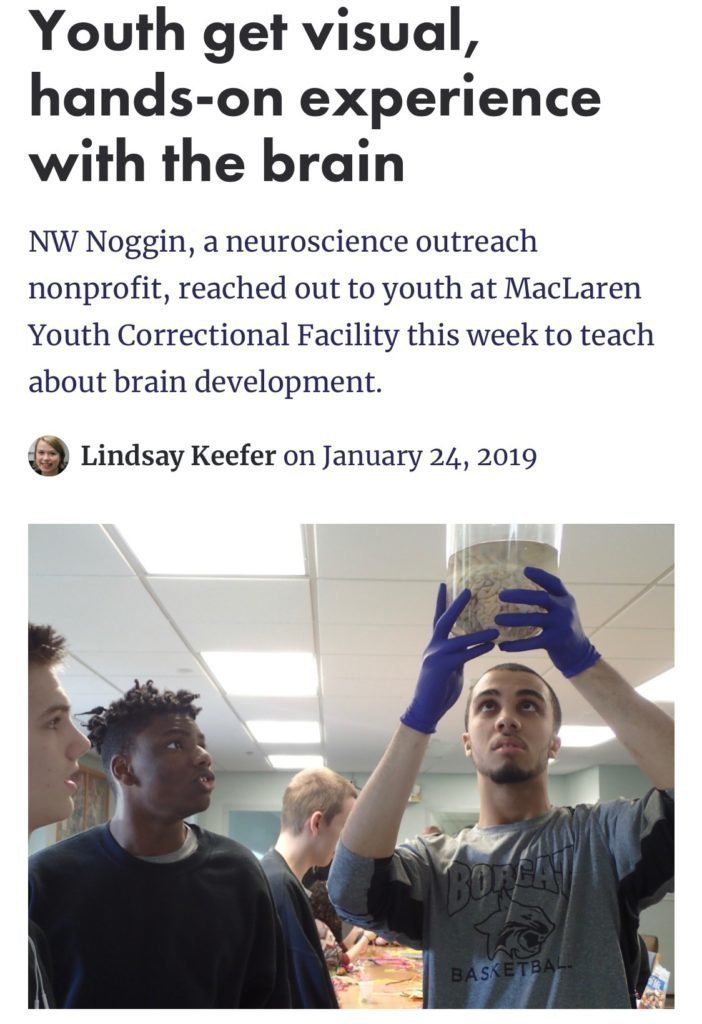Oregon Tries and Fails to Eliminate Daylight Savings Time, for Now

February, 2024
Oregon’s state senate failed to advance a bill on Tuesday that would have abolished daylight saving time in most of the state and switched it to standard time for the entire year, the latest chapter in an effort by states to settle on whether clocks need to fall back or spring forward at all.
The bill proposed that the part of the state in the Pacific Time Zone — almost all of the state is, save Malheur County, which is on Mountain time — abolish “the annual one-hour change in time from standard time to daylight saving time.”
The measure isn’t entirely dead: The state senate sent the bill back to committee to be amended to make sure that if it were to happen Oregon wouldn’t be the only state in the region switching to permanent standard time.
Lawmakers in Oregon’s neighboring states have proposed similar bills. In Idaho this week, a bill was introduced to get rid of daylight saving time, and there is a similar bill in front of California’s Assembly. In Washington State, a bill to abolish daylight saving time and return to permanent standard time failed last month.
“We are leading the way,” Kim Thatcher, a sponsor of the Oregon bill, said on the State Senate floor this week before the bill’s failure. “I think we’re not going to be alone in this, but there might be a little weirdness at first, just know that.”
Oregon would have been the first West Coast state to spend its entire year on standard time. Arizona (except for the Navajo nation) and Hawaii also observe standard time year-round. And in 2022, Mexico ended daylight saving time for most of the country, but carved out an exception for the area along the U.S. border.
Daylight saving time has long been a matter of debate. Why do we change the clocks in the first place? Is doing so still — sorry — timely? And if we were to stop changing our clocks, would we freeze them on standard or on daylight saving time?
Since 2007, daylight saving time has begun in the United States on the second Sunday of March, when clocks spring forward an hour, and ended the first Sunday of November, when they fall back. (Get ready: This year, the clocks spring forward on March 10 and go back on Nov. 3.)
The main idea behind daylight saving time, was to move an hour of sunlight from the early morning to the evening so that people can make more use of daylight. Benjamin Franklin, while in France in the 18th century, is often credited as the first to suggest it.
Another argument in favor of the clock change, according to some, is that having sunlight later in the day can save energy costs, but there have been conflicting studies about whether it really does. People don’t seem to be fans, either: According to polls over the years, most Americans don’t like changing the clocks twice a year, and the days after the switch can be a turbulent time for public health. Daylight saving time still has some supporters, especially among business advocates who argue it helps bolster the economy.
The U.S. Senate passed legislation in 2022 that would do away with the time changes and make daylight saving time permanent. The U.S. House of Representatives hasn’t yet taken up the measure.
That bill is different from Oregon’s proposal, which would stop the clock on standard time.
Scientists generally prefer a permanent switch to standard time (the time in winter) rather than daylight saving time (the time in summer).
“Our ability to sleep well, as we know from experience, is profoundly impacted by exposure to light,” Bill Griesar, a teaching assistant professor at Portland State University, wrote in a public testimony this month. He added that standard time was “best aligned with the natural circadian rhythms of our own brains and bodies, allowing us to wake up more days of the year in sunlight.” (In other words: In permanent daylight saving time most people are probably commuting to work in the dark, but in standard time the sun is probably up around that time.)
The American Academy of Sleep Medicine called for the abolition of daylight saving time in 2020, saying that the shifts, by disrupting the body’s natural clock, could cause an increased risk of stroke and cardiovascular events, and could lead to more traffic accidents.
LEARN MORE: Permanent Standard Time is best for your brain
Oregon may halt daylight saving time this year, without congressional approval

February, 2024
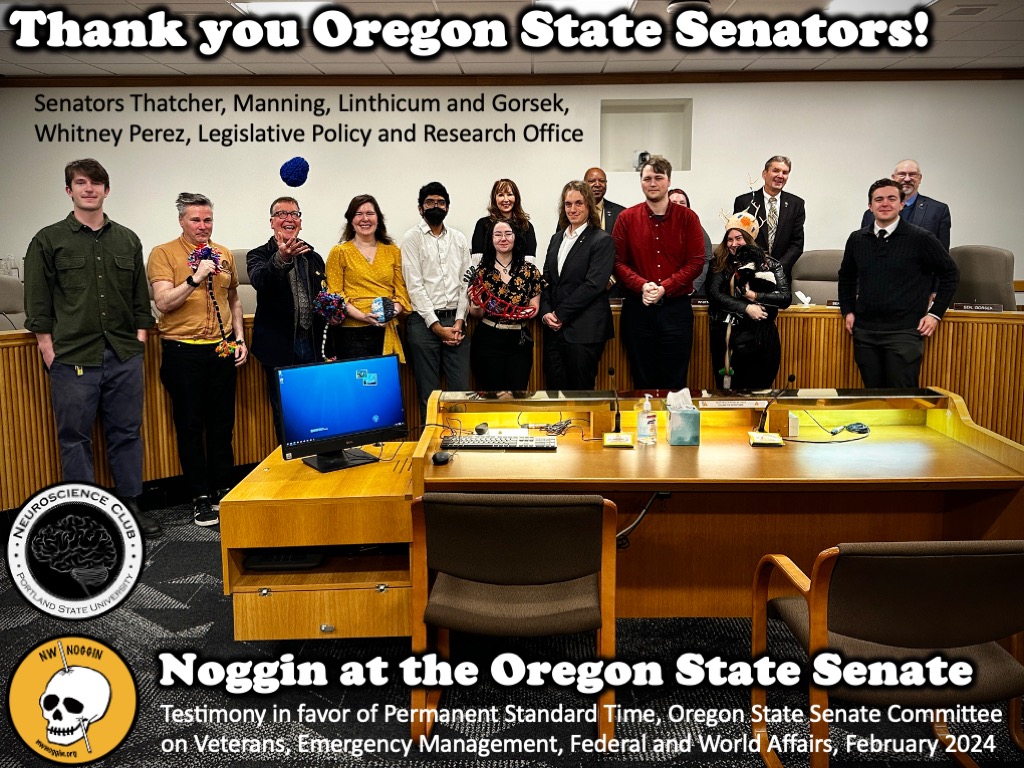
An Oregon state senator has introduced legislation she said is a better option than the daylight saving bill that continues to stall in Congress.
Kim Thatcher, R-Keizer, said Senate Bill 1548 would adopt Pacific Standard Time for 12 months of the year, putting an end to switching from standard time to daylight saving time in the spring and then back to standard time in the fall….
…Lawmakers in the Veterans, Emergency Management, Federal and World Affairs committee held an informational meeting for the bill on Tuesday. Portland State University students and professors who volunteer with the nonprofit organization Northwest Noggin testified in support of the bill.
“Permanent standard time in Oregon, and the sleep benefits that will accompany it, will have positive impacts on the health, well-being and success of Oregonian students,” Chenard said.
Bill Griesar, a teaching assistant professor of interdisciplinary neuroscience at PSU, said exposure to light profoundly impacts people’s ability to sleep well.
“Permanent standard time is best aligned with the natural circadian rhythms of our own brains and bodies, allowing us to wake up more days of the year in sunlight,” Griesar said…
LEARN MORE: Permanent Standard Time is best for your brain
NW Noggin Brings Neuroscience Fun to Rural Oregon Students
October, 2023
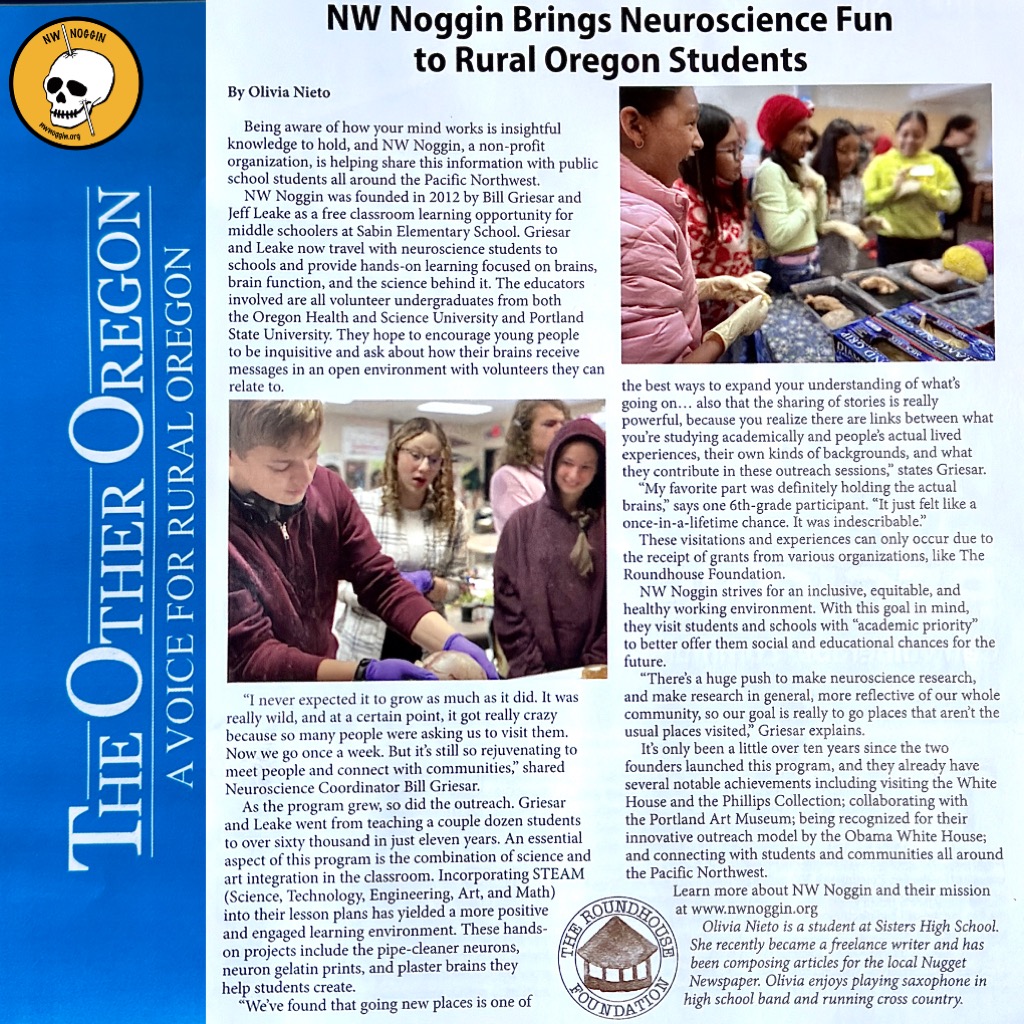
NW Noggin Brings Neuroscience Fun to Sisters Students
May, 2023

LEARN MORE: NW Noggin Brings Neuroscience Fun to Sisters Students
The Roundhouse Foundation Announces 2022 Fall Open Call Grant Recipients
December, 2022
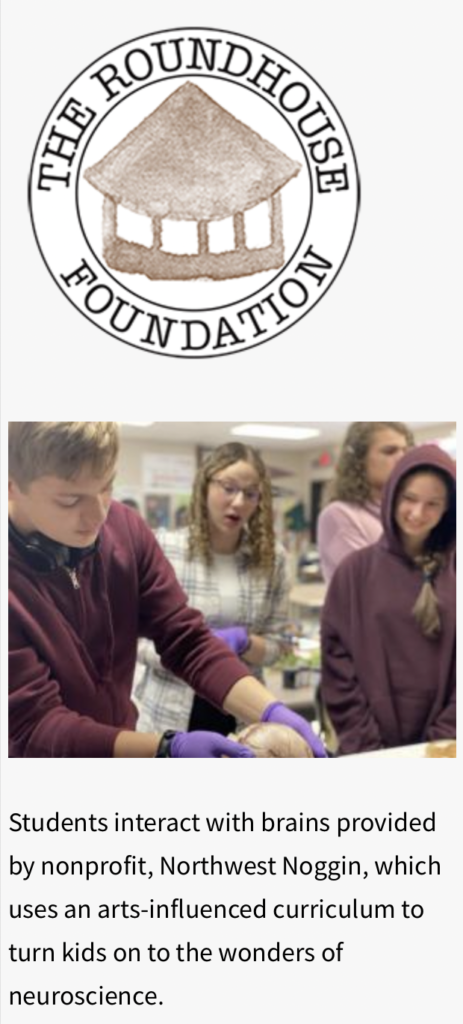
SISTERS, OREGON, UNITED STATES, December 13, 2022 /EINPresswire.com/ — The Roundhouse Foundation, has announced its final selections for the Fall Open Call Proposal cycle. The foundation supports programs and projects that focus on four main areas: arts and culture, environmental stewardship, social services, and education. A total of just over $1.7 million was awarded to 95 organizations working across Oregon to support rural and Tribal communities.
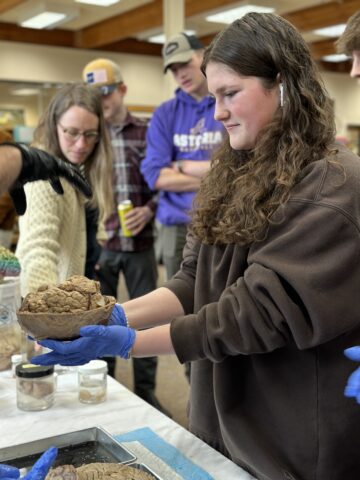
– Northwest Noggin: to support interdisciplinary outreach in rural Oregon surrounding the group’s efforts to engage people creatively in neuroscience and brain research, and to help bring 30 volunteers to over 1,000 rural K-12 students across the state. (Statewide)
LEARN MORE: Roundhouse Receptors!
Noggin + TRIO in Portland Public Schools
December, 2021
Dec. 14, 2021  MESD in the News An Axonal Alliance from the NW NOGGIN: Neuroscience Outreach Group  Neuroscience connections and youth mental health collaborations with the Alternative Pathways/Trio program at MESD were mentioned on the NW NOGGIN website Dec. 11, 2021. LEARN MORE: MESD Newsletter. Read the Article |
Patton Middle School lesson combines literature and science
July, 2021
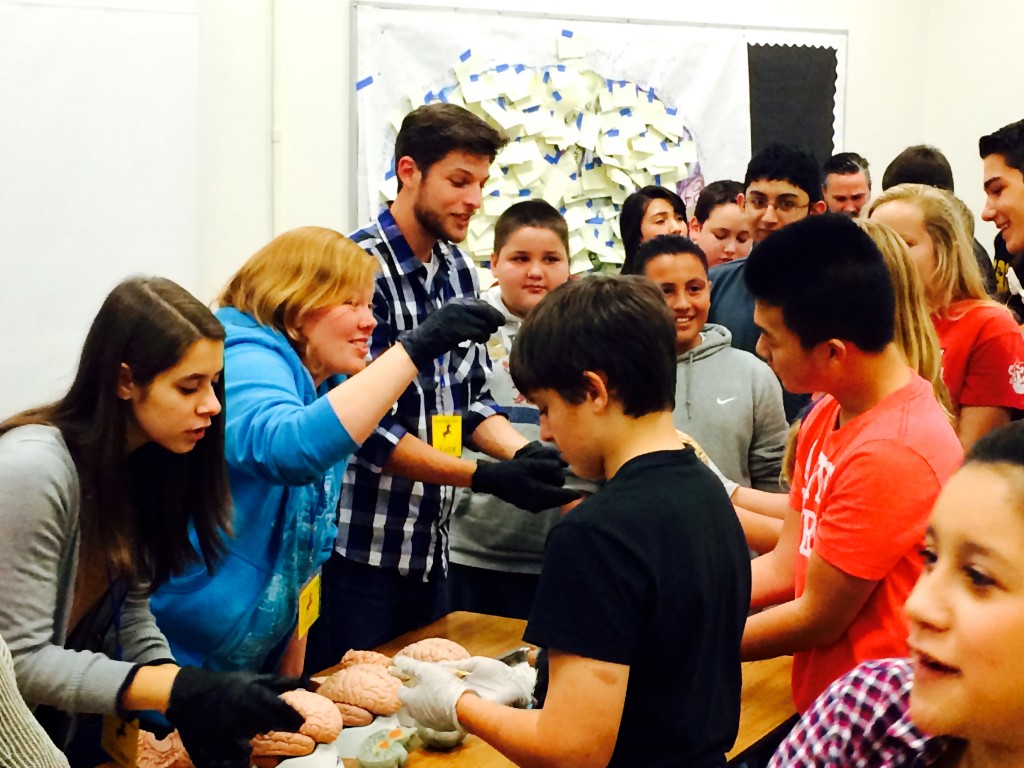
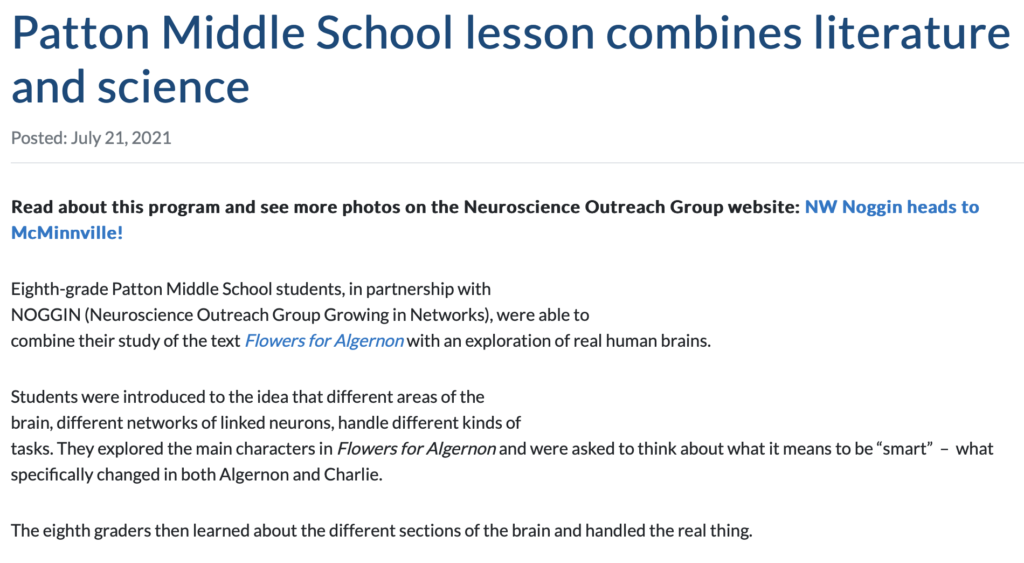
LEARN MORE: NW Noggin heads to McMinnville!
PSU Faculty Feature: Dr. Bill Griesar
April, 2021
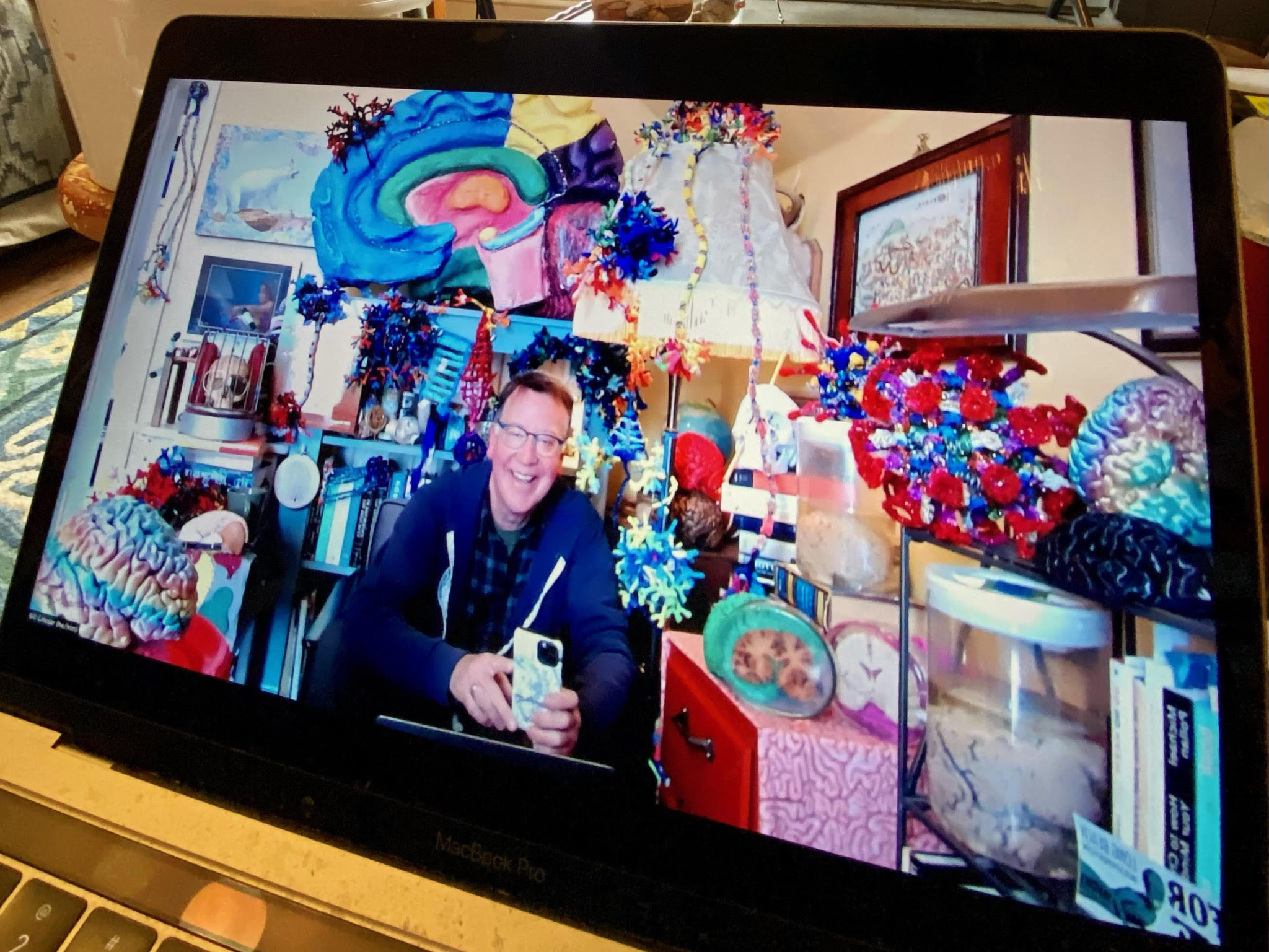
“We tell students they have amazing potential. Go places, don’t wait for institutions.”
NEUROSCIENCE FOR KIDS NEWSLETTER
April 2021

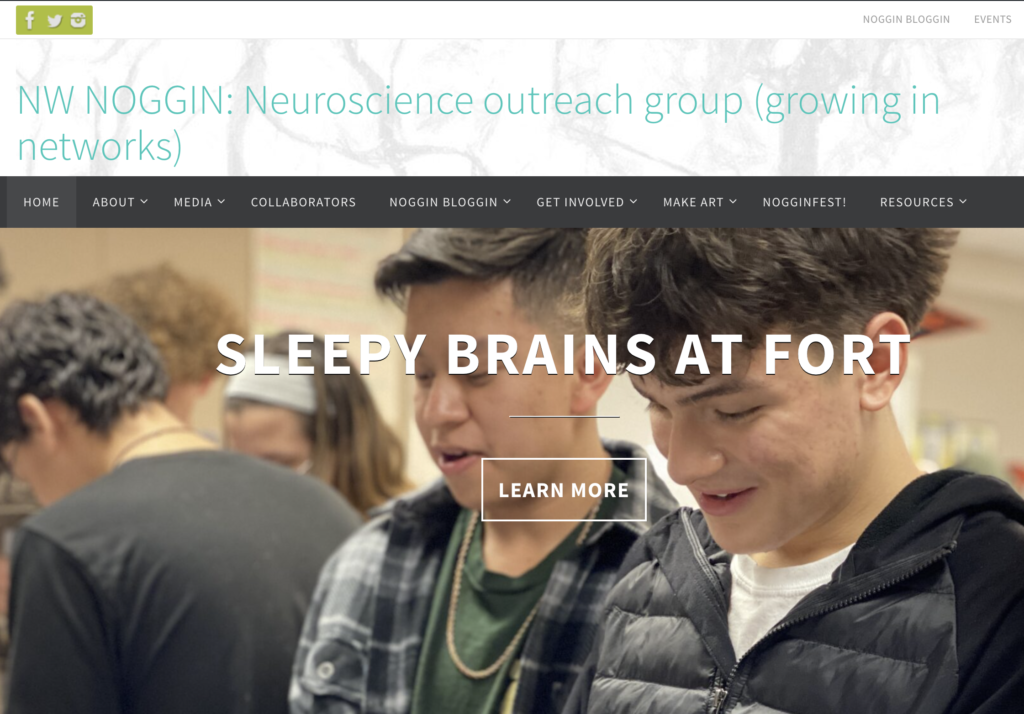
NogginFest Looks Different this Year, but the ‘Spirit of the Event’ Hasn’t Changed
March, 2021
The annual celebration of art, music, and neuroscience, happening March 20, will be all virtual this time around.
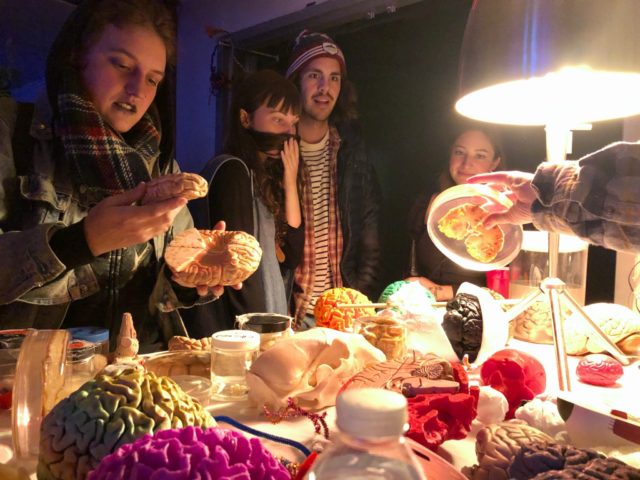
LEARN MORE: NogginFest Looks Different this Year
p:ear: Our Virtual Gala Was a Big Success!
June, 2020

NW Noggin & PDX3DP Lab: 3D Printing Brain Models for Students in Oregon
May, 2020
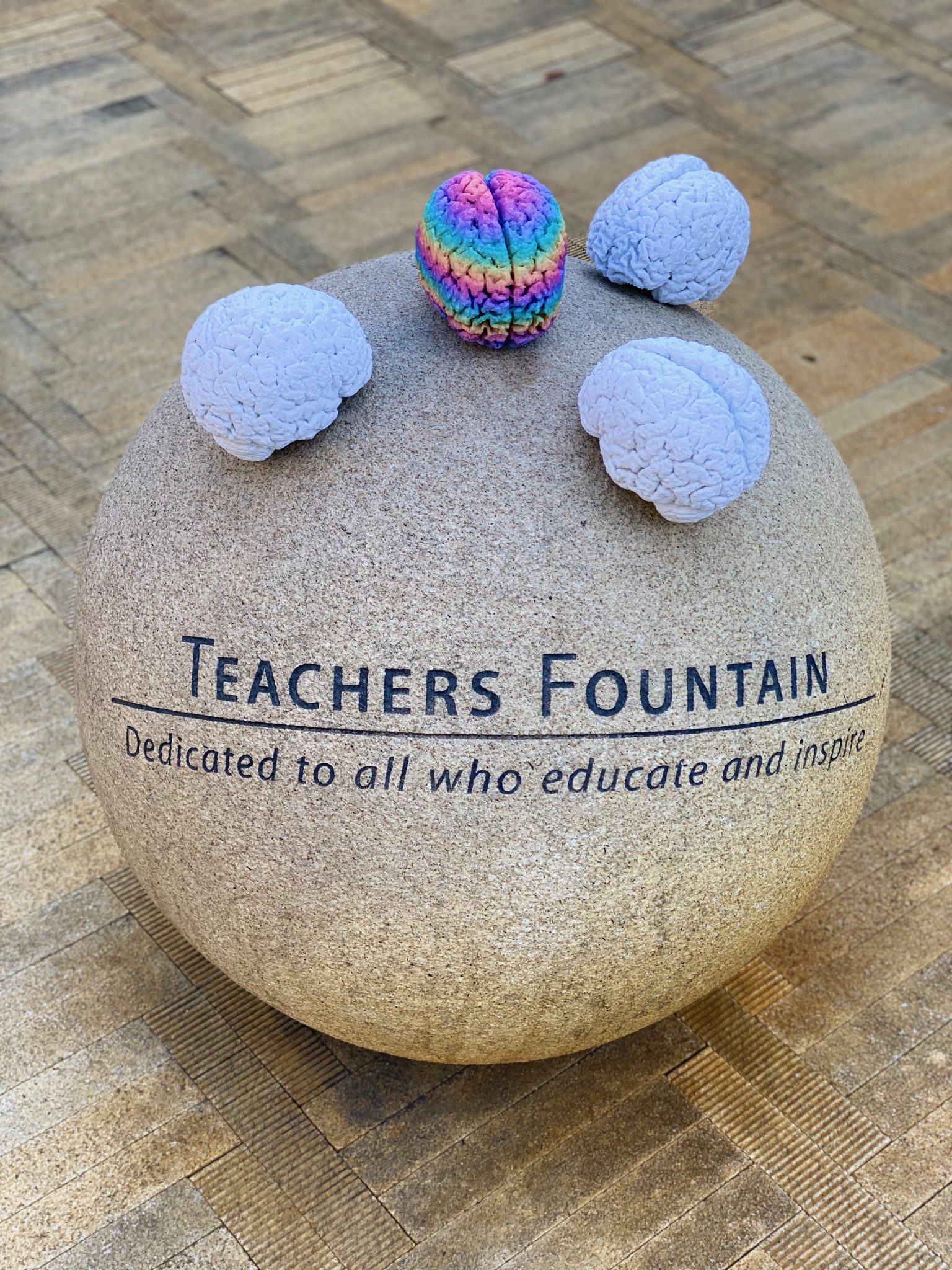
“On three consecutive Thursdays – May 14, 21, and 28 – from 10-10:45 am, the NW Noggin Online team will conduct Google Hangouts for students in 6th-8th grade at the PPS Creative Science School. The volunteers will be answering questions from students, and they’ll show 3D printed brains and real animal brains on the screen, in addition to hosting a talk with neuroscience graduate students and providing some interesting at-home art project ideas.”
READ MORE: 3D Printing Brain Models for Students in Oregon
COVID-19 on the Brain
April, 2020
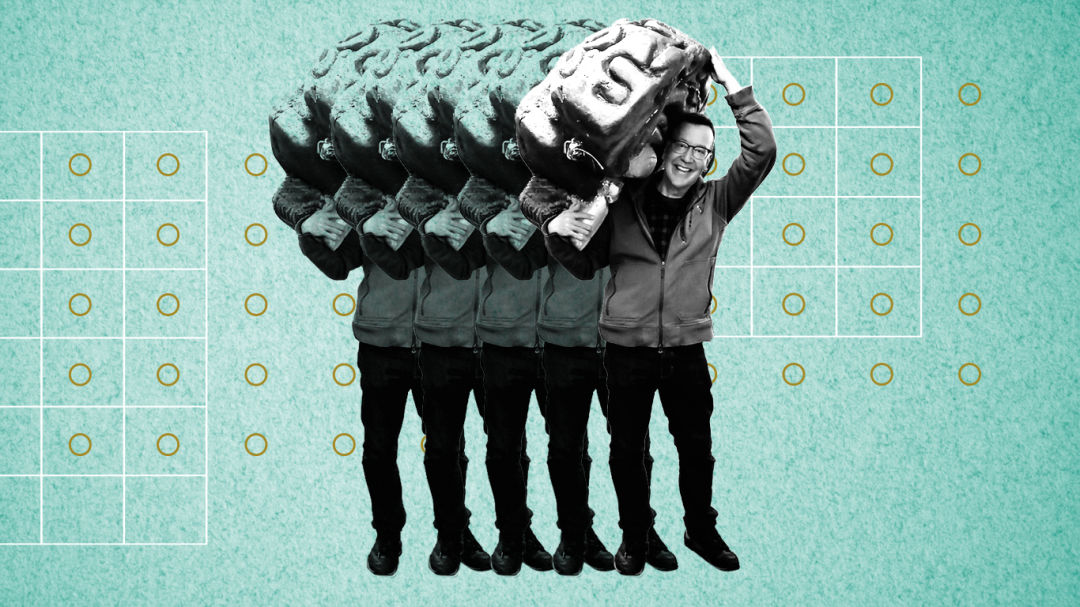
“Reaching out to others, checking in, listening to what people say, asking if you can do anything (get groceries, for example)—and asking for help or assistance yourself if you need it are all important steps we can take,” says Bill Griesar, senior instructor in the department of psychology at Portland State University. He talks virtual communication, touch, and what neuroscience can tell us about the impacts of COVID-19 in this extended Q&A.
READ MORE: COVID-19 on the Brain
Getting kids excited about neuroscience
March, 2020
An Oregon nonprofit brings an actual brain, and brainpower to classrooms
Students get a real hands-on experience, even holding a human brain, as the nonprofit teaches lessons in neuroscience.
PORTLAND, Ore. — Getting the attention of middle school science students is a no-brainer for NW Noggin.
Students get a real hands-on experience, even holding a human brain, as the nonprofit teaches lessons in neuroscience.
“We are all volunteers going into classrooms learning what kids are curious about. They ask so many questions,” said NW Noggin founder Bill Griesar.
Since 2012, the nonprofit has reached 40,000 students. On Tuesday, they visited Portland’s Hosford Middle School bringing plastic models of brains, preserved sections of the brain and a real one to hold.
“It’s heavier than I thought it would be and squishy,” recalled one student.
The program relies on graduate students from OHSU and PSU.
“We bring these advanced students into classrooms so the kids can see the possibilities. Maybe they will want to follow a similar path someday,” said Griesar. NW Noggin has taken its program to other cities such as Chicago and Washington D.C. This Saturday, March 7, they’ll be at OMSI’s Brain Fair.
“It’s really cool,” one student said. “This was a super fun day.”
NW Noggin and KGW visit Hosford Middle School in Portland, Oregon.
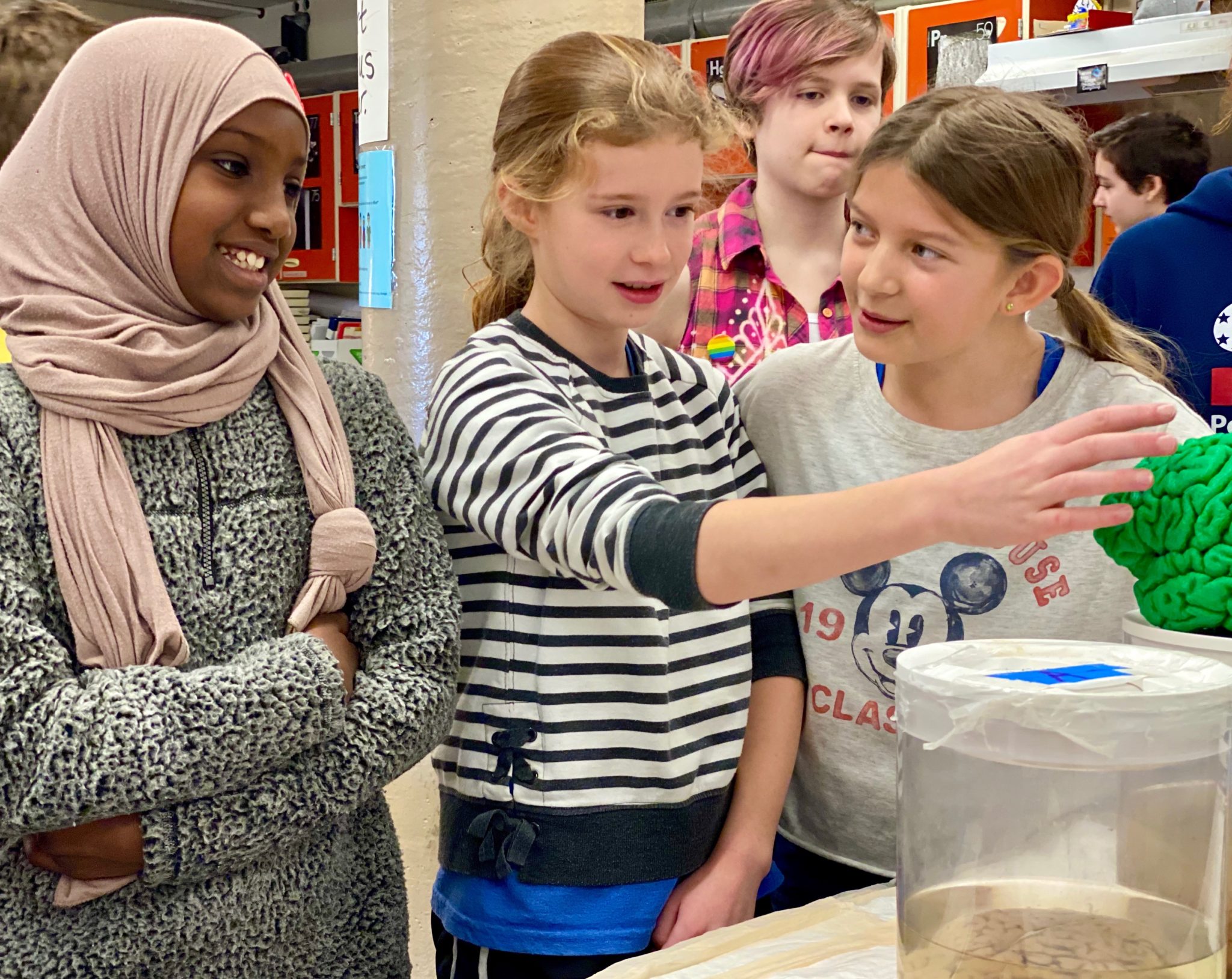
Take A Nap! Sleep Deprivation And The Brain
February, 2020

The CDC recommends a minimum of 7 hours of sleep per day for healthy brain function in adults, but during an interview with The Pacific Sentinel Dr. Bill Griesar—senior instructor at Portland State University and Neuroscience Coordinator of Northwest Neuroscience Outreach Group Growing in Networks (NW NOGGIN)—added that adolescents, including college-aged youth, require approximately 8–9 hours of nightly sleep to remain healthy.

LEARN MORE: Sleep Deprivation And The Brain
3D-Printed Neuroscience Models for Everyone
February, 2020

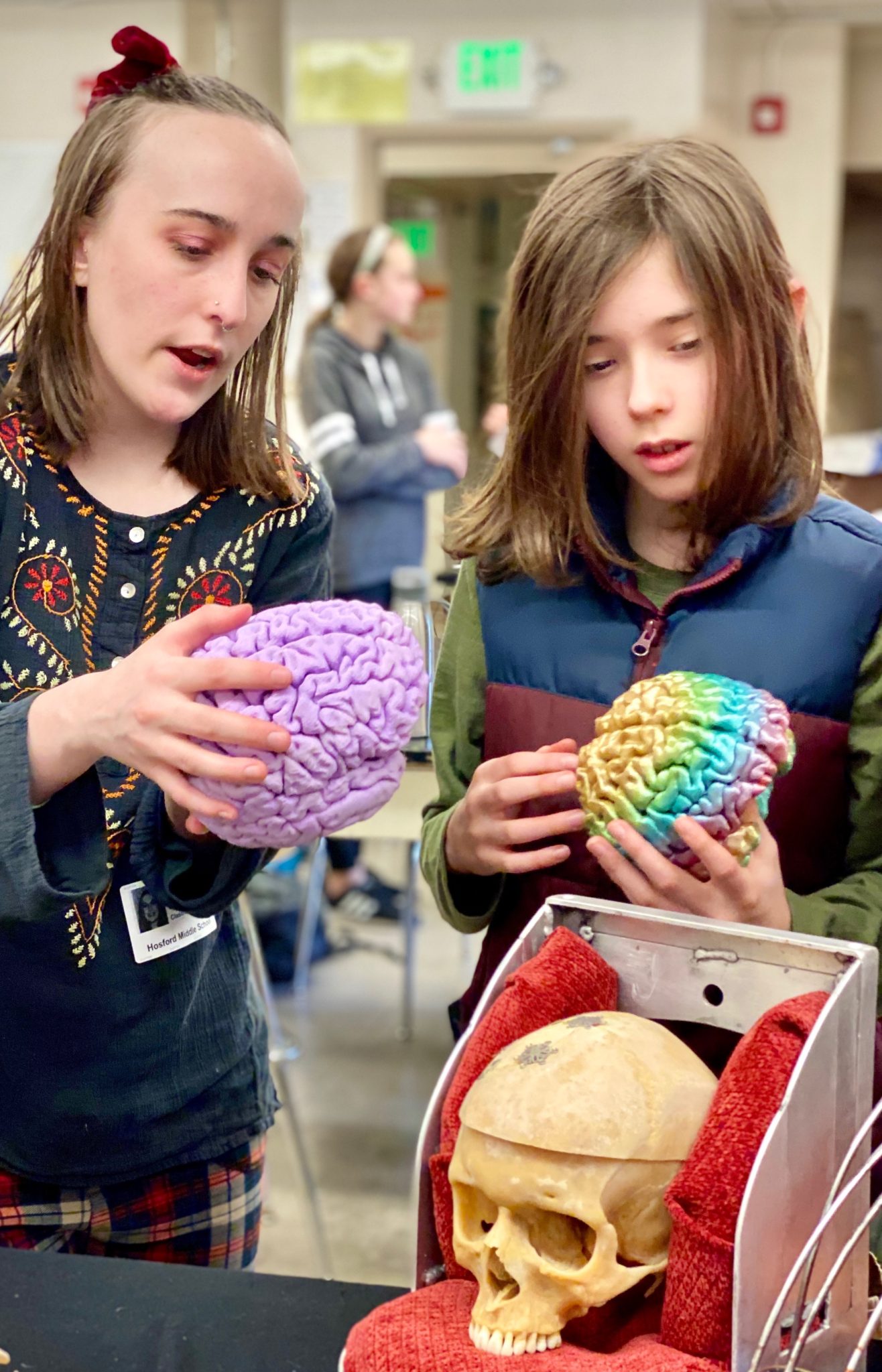
The Brain Awareness Campaign Event at the Society for Neuroscience meeting in November was a celebration of outreach achievements from all over the world. Led by Bill Griesar and Jeff Leake (founders of NW Noggin, a volunteer-driven outreach organization), the event explored many creative ways people share neuroscience in their communities. The NW Noggin team decorated the lecture stage with large, elaborate neurons made from colorful pipe cleaners and life-size 3D-printed brain models. While the neurons were quite stunning, the 3D-printed brains captured my eye, as I was attending the meeting to share my experiences using 3D-printed anatomy models in undergraduate courses (SFN meeting presentation # 024.13SU/LLL27). I left the event wondering, how many of us are making our own 3D-printed neuroscience models and how many of us would benefit if we could share them quickly and easily?
Brains, trains and homelessness: How public transit can respond to neuroscience
December, 2019
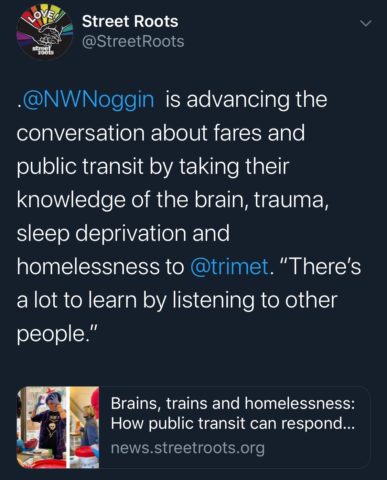
LEARN MORE: NW Noggin @ p:ear
All is in motion, is growing, is you
January, 2019
LEARN MORE: Youth get visual, hands-on experience with the brain
It’s not every day you get to hold a human brain in your hands.
But this week, youth at MacLaren Youth Correctional Facility got to get up close and personal with human and animal brains, skulls, and eyeballs, thanks to a visit from NW Noggin, a neuroscience outreach nonprofit group.
Youth in three different units were able to visit with about a dozen NW Noggin volunteers to learn about the brain, to study and, in some cases, handle research materials like bobcat eyeballs and the brain of a meth user, and to create art with pipe cleaners.
“When you put yourself into art, have ownership of an idea, then you tend to ask more questions,” explained NW Noggin’s Bill Griesar, a professor of neuroscience and psychology at Portland State University. Most of the visiting neuroscience volunteers are from PSU and OHSU.
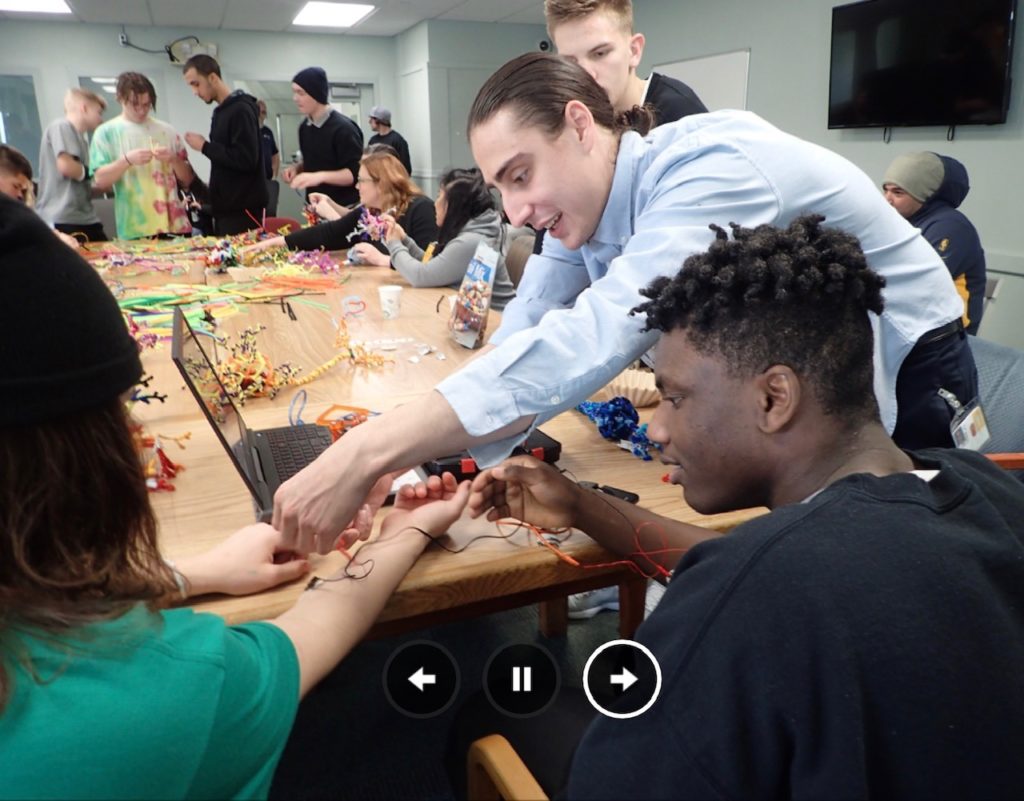
Also during this visit, the youth were able to try out a human-to-human interface that has electrodes placed on the muscles of one person’s arm. When that individual moves their hand, it signals the circuit board to deliver an electric shock that stimulates the muscles in a second person’s arm.
“All this demonstrates how information is carried by electricity — moving charges — both in copper wires, and in those biological axon wires that make up neural networks allowing us to move, perceive, remember and decide,” Griesar said.
This is NW Noggin’s second visit to MacLaren, the first time having been in September 2018 when the focus was more on discussions of research and what role neuroscience can play in judicial and legislative reform.
“Last time we didn’t have the opportunity to do art,” Griesar said about part of the reason the group returned. “We find it encourages the kids to ask more questions.”
Youth did ask many questions, including Curtis D., who later said, “It’s really interesting. I’d like to be a teacher; maybe I can teach about the brain.”
Another youth with a traumatic brain injury learned a lot about how he can exercise his brain, having previously believed that any damage done was irreversible.
“They can see that there are steps you can take that are actionable toward changing your brain,” Griesar said. “It’s more changeable than you think — especially for young people.”
NW Noggin, which Griesar said is making plans to return to MacLaren, doesn’t just come to instruct, but to glean from the youth, as well.
“We like to come here because we value their perspective, their different experiences,” Griesar said. “We learn a lot from them, too.”
NW Noggin’s visit is thanks to a connection through the Hope Partnership, an initiative through Janus Youth Programs that creates community connections for incarcerated youth through arts, life skills, vocational training, and transition services programs. Kathleen Fullerton, project coordinator of Hope Partnership, was thrilled to see NW Noggin return to MacLaren.
“Staff can tell the youth that this is going on in your brain, and they can say yeah, sure,” she said. “But to be told by these experts in the field in a relaxed environment is so powerful.”
Raising Brain Awareness With Pipe Cleaners, Pens, and Paper
January, 2019

Bill Griesar and Jeff Leake, cofounders of the neuroscience outreach nonprofit NW Noggin, in Portland, Oregon and Vancouver, Washington, share examples of how their undergraduate and graduate student volunteers use art to connect with youth in their community.
Through art, which encourages self-expression and problem solving in different ways, NW Noggin helps kids see how neuroscience relates to their lives — and shows them how they can pursue a career in neuroscience.
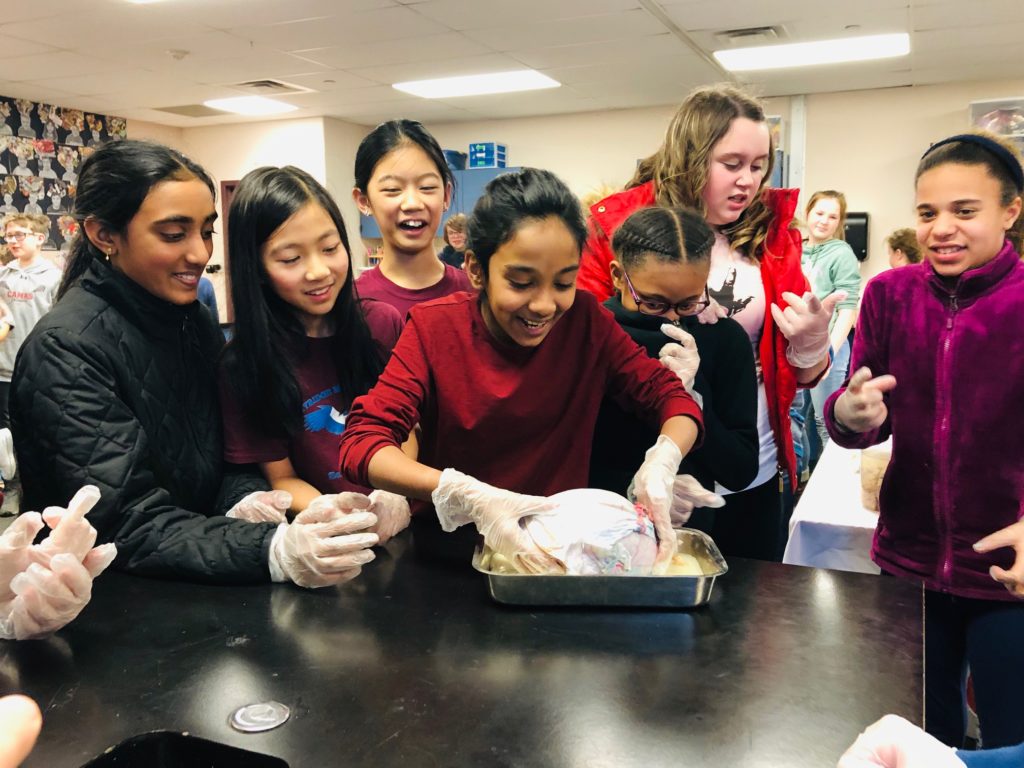
“When young people see near-peers to them studying sleep or anxiety and the brain, it suddenly makes the things that are going on in the classroom much more relevant. It helps them understand how research on the brain relates to their experience and that they can do what those people are doing,” Griesar says.
Watch this recording from the Brain Awareness Campaign Event at Neuroscience 2018 for ideas on how to initiate outreach in creative places and through strategic partnerships to share neuroscience with your community.
WATCH VIDEO: Raising Brain Awareness With Pipe Cleaners, Pens, and Paper
LEARN MORE: Synapsing in San Diego @ SfN!
Montgomery, Linda Vista and Carson students get brainy with university neuroscientists
November, 2018
San Diego Unified School District NewsCenter
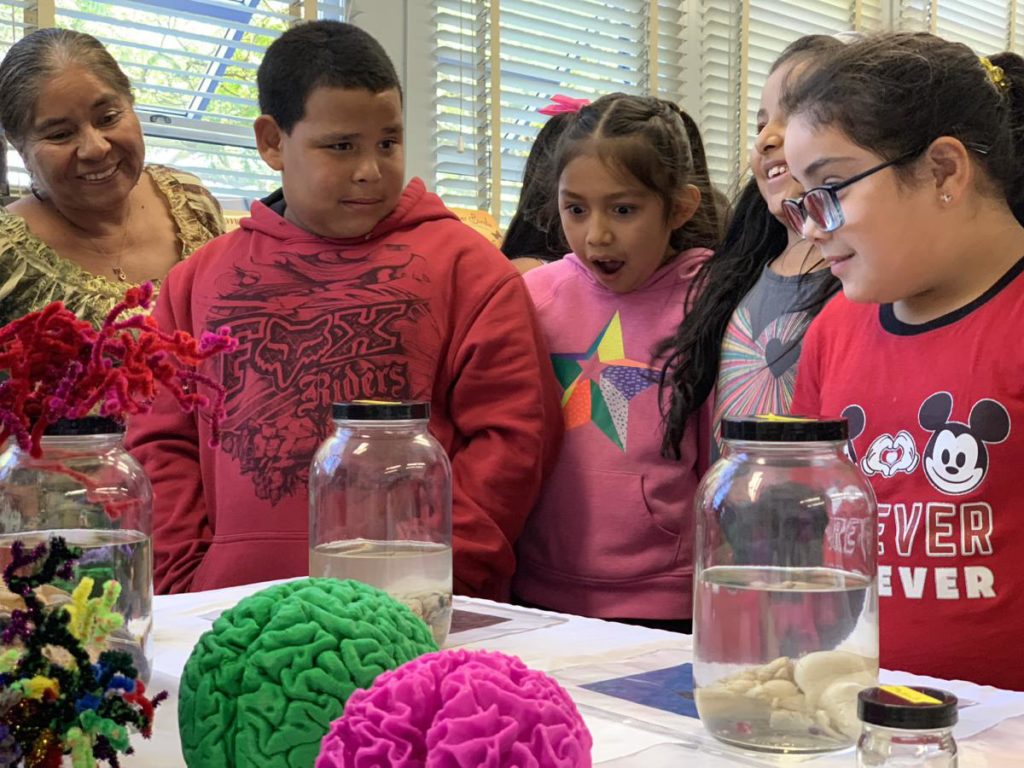
“I have 86 billion of these in my brain,” the teacher says to a group of seventh graders, as she displays a colorful conglomeration of pipe cleaners pieced together in an alien-looking shape. “And so do you!”
Emalyn Leppard, a resource teacher at Montgomery Middle School, is holding a model of a brain neuron that she just assembled with the assistance of neuroscientists from NW Noggin, a nonprofit science outreach organization visiting from Portland, Ore.
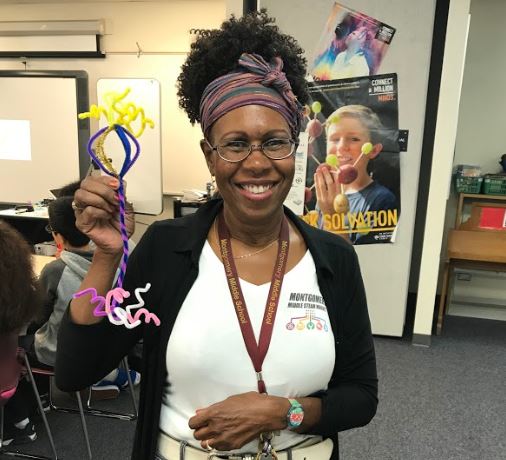
The interactive art project is just one small part of a two-day session putting real scientists from Portland State University and Oregon Health & Sciences University into San Diego Unified classrooms. This year, the Noggin group is visiting Carson Elementary, Linda Vista Elementary, and Montgomery Middle to provide an in-depth lesson on neuroscience – the function and structure of the brain and nervous system.
“It’s a great example of the connection between science and art,” says MSAP Resource Teacher Rob Corona. “By creating this aesthetically pleasing model, students are using art to tell the story of how the brain works.”
Art is only the beginning of the lesson, however. So what captures the attention of a seventh grader more than a fun hands-on art project? How about a real, full-sized brain right in front of them?
NW NOGGIN WILL TRAVEL TO THE YAMHILL AND LINCOLN COUNTY REGION
October, 2018
Oregon Pacific Area Health Education Center
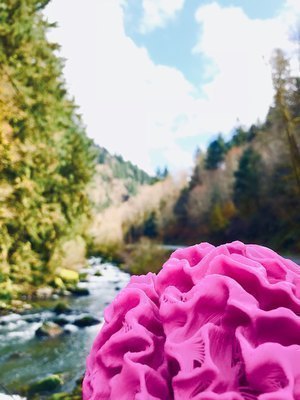
NW NOGGIN is partnering with OPAHEC to offer students enrolled in Pathways to Healthcare Careers Club opportunities to learn about neuroscience and health occupations through art. The program is entitled Synapses, Stories, and Song. NW NOGGIN plans “to bring twelve Noggin undergraduate and graduate student volunteers studying neuroscience and art to Siletz Valley Schools, and Willamina, Amity, and Sheridan High Schools, October 8 – 11 for three, day long visits aimed at making connections between figures in Grande Ronde and Siletz tribal stories (including Coyote, Crow and Grizzly) and their relevant neuroanatomy…”
On June 7th OPAHEC staff, Siletz Valley School faculty and Bill Griesar met to begin planning the fall event at Siletz Valley School; drawing upon resources from the local community, music and art and dance activities are being planned to synergize the event to include human and animal brain specimens to learn about neuroscience.
LEARN MORE: Synapses, Stories & Song!
NW Noggin
June, 2018
By Ashley Keates, June, 2018

NW Noggin brings together students, scientists, educators, and artists to enthuse and inform academic priority K-12, and the public, about science and art. Participants integrate arts to collaboratively develop outreach programs designed to be engaging and personally relevant. NW Noggin seeks to spark a lifelong interest in science and art, provide teaching opportunities, and foster understanding and enthusiasm for ongoing scientific research and art in our community.
LEARN MORE: GRASSROOTS BEGINNINGS…
The Art and Science of the Brain: NW Noggin makes neuroscience fun
March, 2018
Author: Cristina Rojas, CLAS Media Relations Posted: March 6, 2018
The brain is a lot to wrap your mind around.

The 3-pound mass of fatty tissue is the most complex structure known to humankind, but thanks to the NW Noggin program run by two Portland State University instructors, thousands of kids have been given a chance to explore the mysterious organ up close and personal.
March 12 through 18 is global Brain Awareness Week. But for Bill Griesar and Jeff Leake, who both teach in the psychology and university studies programs at PSU’s College of Liberal Arts and Sciences, increasing awareness of the progress and benefits of brain research is a year-round effort.
They, along with undergraduate and graduate students from PSU and other area colleges, regularly travel to often-overlooked schools across the Portland metro area and state, giving students in grades kindergarten through 12 hands-on lessons in neuroscience.
They bring along some unusual props: containers full of pipe cleaners, brightly colored 3-D-printed models of brains and an assortment of real brains from humans and animals like a cat, chicken, fish, sheep and raccoon.
“You brought human brains?” some students say in awe.
To which Griesar responds: “Yeah, you did too.”
“You don’t think of yourself as actually being made of things that are growing and changing and responding to your environment,” he said. “That’s kind of powerful. That’s actionable information for kids.”
The group’s visits are a mix of science and art. The kids touch the brains — some enthusiastically, others less so — as well as pepper the PSU instructors and college students with questions that range from the effects of smoking on the brain, to dreams and nightmares, as well as work on art projects like constructing neurons out of pipe cleaners or drawing visual metaphors of brain structure and function on a large map of the lobes.
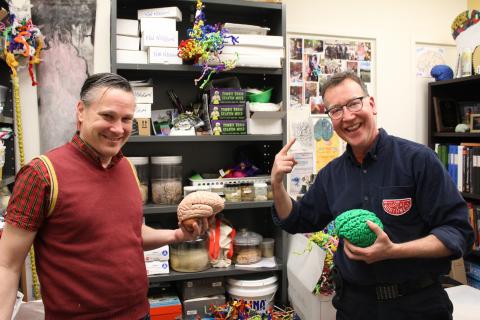
Griesar and Leake say that beyond exploring the brain, they hope their visits spark an interest in learning and perhaps plant the seed of a future career.
Judging from the enthusiastic response they get, their fun, cross-disciplinary approach appears to be working.
“They’re transfixed,” Griesar said. “If there’s something that motivates you or you’re interested in, that’s going to drive your engagement. When you actually start talking about the brain and answering these sharp, direct questions, they’re totally engaged. They’re totally excited about learning more and wanting to do more.”
The idea for NW Noggin came about in 2012 when Griesar and Leake, both parents of children in Northeast Portland’s Sabin K-8 School, saw the cuts being made to the arts and sciences and wanted to create a program for the kids in the Multnomah County-run Schools Uniting Neighborhoods (SUN) summer program that would incorporate academics and enrichment activities.
They combined their expertise — Griesar, neuroscience, and Leake, art — and recruited student volunteers from area colleges including Portland State, Oregon Health and Science University, Pacific Northwest College of Art and Washington State University’s Vancouver campus to develop a four-week class on the brain and behavior.
It was so successful that they expanded to three schools the following summer, then five before turning it into a year-round venture.
Griesar estimates that the brains have been held by some 18,000 students. They’ve also traveled to the annual meeting of the Society for Neuroscience and Congress, making stops at local public schools in San Diego and Washington, D.C.; hosted talks at VeloCult, a bike shop that serves coffee and beer; and collaborated with p:ear, a community center of sorts for homeless youth.
NW Noggin was honored on March 1 with an “Out of the Ordinary” award at the Regional Arts & Culture Council’s annual Juice breakfast for giving children “a unique opportunity to learn about neuroscience and the brain using nontraditional, artistic methods that make the information more accessible and impactful.”
Leake said the integration of the arts helps kids connect with the material in a way that traditional teaching and standardized tests do not allow.
“What I was really wanting to do was give students a way to make some of these concepts …and some of these things that they may not normally think of as having really anything to do with them personally relevant and also give them an opportunity to explore these concepts without having to worry about, ‘Did I get the right answer for this or not?'” Leake said.
“So many of the students that we work with have sort of struggled with the academic system the way it is now,” he said. “A part of it is letting them know there’s other ways to learn things and that this stuff isn’t beyond them.”
Leake encourages them to draw on their own experiences. For example, they or someone they know may suffer from depression or have had a concussion.
“That makes it much more impactful because this has something to do with them,” he said.
Another goal of the program is to inform and excite the public about ongoing neuroscience research. Griesar said he wants research to inform policy and hopes to empower the kids.
“We want to tell students honestly about what it is we know so far, what don’t we know …, what are the limits of some of the techniques or technologies we use to get info and data, and also what do they think we should do with this information?” he said.
The kids often ask questions or give their opinions about later school start times or the minimum age for smoking cigarettes and marijuana — and Griesar said the research can be a great starting point for those discussions.
But it’s not just the kids who get something out of the program. For the undergraduate and graduate students who accompany Griesar and Leake on the trips, they learn how to teach kids about brains and neuroscience in lay terms, connect with mentors, explore career possibilities that they otherwise might not have considered and carry out PSU’s motto to “Let knowledge serve the city.”
“Once they start doing it, they come back again and again,” Griesar said. “There’s something really powerful about that ability to connect to a community.”
For more information, visit NW Noggin’s website.
Photos:
Above: Students handle brains in a NW Noggin session.
Below: Jeff Leake, left, and Bill Griesar are the brains behind NW Noggin.
RACC Announces the 2018 Juice Honorees
January, 2018

ON MARCH 1, 2018, RACC GATHERED ART & CULTURE MAKERS AND SHAKERS FROM THE PORTLAND METRO REGION TO HONOR THE MOST INNOVATIVE, CREATIVE, AND PRODUCTIVE. THE HONOREES ARE LISTED BELOW…
This year’s award-winners are:
Using the Power of Space and Place
Valerie Otani
New Expressive Works and WYSE Real Estate Advisors
Out of the Ordinary
Kevin Cavenaugh, Guerilla Development Co.
NW Noggin
YWCA/Fred Meyer and Imago Theater
Elevating Voices / Changing the Conversation
Profile Theatre
Paul Susi
August Wilson Red Door Project and Portland Police Bureau
From Society for Neuroscience
February, 2018
“Science advocacy is very important in this day and age. Scientists, we as a community, are very good at communicating with one another, but I think we need to be much better about communicating with the lay audience, the public as a whole, to get our message across. Because we can’t do any of our science without the public’s support, and at the end of the day, all of our science is for the public’s benefit.” – Sai Sachin Divakaruni
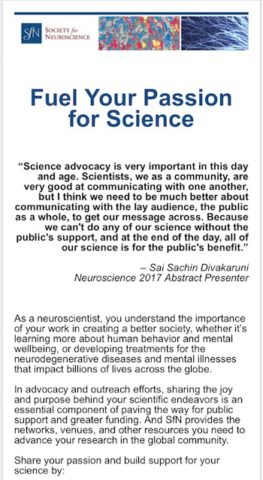
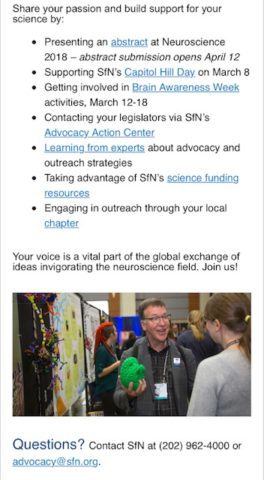
From Congresswoman Suzanne Bonamici
December 2017 STEAM Newsletter
December, 2017
Dear Friend,
It has been an exciting end to the year for the Congressional STEAM Caucus. For the second year in a row, the STEAM and Neuroscience Caucuses hosted a “Brains + Art” briefing with the American Brain Coalition and NW Noggin to bring artists and scientists together to educate students about brain development and arts-integrated neuroscience. Upon returning to Oregon, NW Noggin received a STEAM grant from the Confederated Tribes of Grand Ronde for their art and neuroscience outreach proposal “Synapses & Stories; Coyote, Grizzly and their Brains!”

Congresswoman Bonamici delivered remarks about incorporating the arts into science to promote creativity, critical thinking, and innovation.

Congressman Blumenauer discussed the importance of understanding how the brain develops, functions, and ages.
STEAM Caucus members are excited about the STEAM movement in public schools and in education research…The National Academies of Sciences, Engineering, and Medicine launched a study in 2016 to examine the effect of educational experiences that intentionally integrate the humanities and arts with science, technology, engineering, mathematics, and medicine (STEMM) at the undergraduate and graduate levels. Under the leadership of David Skorton, the Secretary of the Smithsonian, the National Academies assembled a 22 member committee comprised of representatives from academia, business, government, and nonprofit organizations with scholarly expertise in the arts, humanities, sciences, engineering, and medicine, as well as expertise in the integration of these disciplines, to carry out this study. The committee will publish a report in the spring of 2018 “that examines the evidence behind the assertion that educational programs that mutually integrate learning experiences in the humanities and arts with STEMM to lead to improved educational and career outcomes for undergraduate and graduate students.”
Thank you for interest in STEAM. In the new year, we look forward to providing more updates on the STEAM Caucus and sharing interesting information about STEAM initiatives around the country.
Please do not hesitate to send us STEAM news, events, or articles at Lakeisha.Steele@mail.house.gov or Patrick.Hester@mail.house.gov.
NW Noggin art project illustrates the feelings of homeless youth
October, 2017
Author: John Kirkland, PSU Media and Public Relations

Posted: October 16, 2017
What does your brain look like on homelessness?
Homeless youth were given a chance to answer that question through an art project called Homelessness and the Brain, organized by NW Noggin, and their works will be on display Thursday, Oct. 19, from 10 a.m. to 1 p.m. at 338 NW 6th Ave. in Portland.
NW Noggin is a nonprofit group of scientists, artists and students that combines art with neuroscience research. In this latest project, NW Noggin and the nonprofit group p:ear supplied homeless youth with paints and other art materials and invited them to express themselves on plaster models of human brains.
“We asked them to re-imagine the landscapes they inhabit, and experience,” said Jeff Leake, Portland State University instructor and Arts Coordinator for NW Noggin.
Bill Griesar, Portland State University psychology instructor and Neuroscience Coordinator of NW Noggin, pointed to a recent survey showing there are nearly 4,200 people in Portland living on the street or in temporary shelters – a 10 percent increase from two years ago.
“Not having a safe place to rest your head affects your brain,” said. “We talked to the participants about how a lack of sleep, chronic stress, inadequate nutrition and social isolation can undermine anyone’s physical and mental health.”
The art project by homeless youth also involves graduate students from PSU, OHSU and other area institutions studying sleep, stress, anxiety, depression, emotional regulation, racial bias, methamphetamine, alcohol, adolescent brain development and resilience. Visitors will have the chance to see some real human brains and speak with researchers, clinicians and members of the homeless community.
The event coincides with a PSU public forum on homelessness: “Can We Solve Portland’s Homeless Crisis,” Tuesday, Oct. 17, from 7p.m. to 8 p.m. at PSU’s Smith Memorial Student Union Ballroom. The event will be televised on KATU-TV (Channel 2) and webcast on katu.com and audience members will have an opportunity to engage in discussion.
Contact John Kirkland at jrk3@pdx.edu
Meet the minds behind NW Noggin, a K-12 neuroscience outreach program
July, 2017
By Rebecca Hood
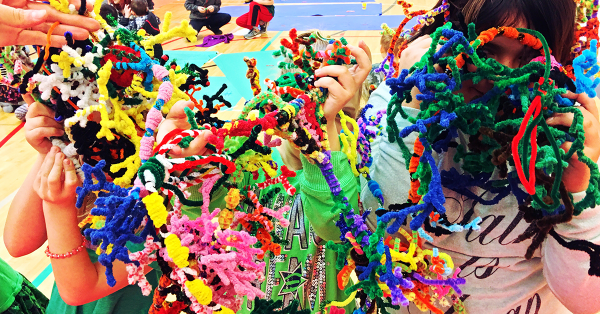
At 8 a.m. in an eastern Washington elementary school gymnasium, Bill Griesar, Ph.D. ’01, is in a situation that would make anyone else sweat.
Dr. Griesar has brought his group of neuroscience outreach volunteers – undergraduate and graduate students hailing from OHSU, Portland State University and Washington State University Vancouver – to Davenport, Wash., to teach schoolchildren about brains and neuroscience.
But he has just discovered that the pipe cleaners used to construct neuron models were nearly used up the day before.
Unfazed, Dr. Griesar immediately concocts a new activity and somehow procures rolls of colored butcher paper from the school. Volunteers from NW Noggin rush to arrange paper on the floor to represent different lobes of the brain.
Scott Jones, a fourth-year Ph.D. student in the OHSU School of Medicine’s Behavioral Neuroscience Graduate Program, tapes out an outline of a brain around the paper just as the first classes come into the gym. Dr. Griesar, simultaneously snapping photos, directing students and showing off a model brain, hasn’t stopped grinning.
Getting Brainy at La Grande High School
May, 2017
By Brittany Hargrove–NEOAHEC Admin. & Outreach Coordinator

Students began by picking the volunteers’ brains—almost literally!–asking questions ranging from topics like dyslexia to the brain’s consistency. Then, smiling ear to ear, the students rotated through several stations where they fashioned neuron replicas out of pipe cleaners, made neuron-like gel prints from plants, explored electrophysiology with a Mind Flex game and other activities, and channeled their inner artist by doodling on a giant paper brain model on the cafeteria floor. Most importantly, the students rolled up their sleeves, plugged their noses, and got up close and personal with real human and animal brains…
Eastern Oregon students wrap noggins around brains
May, 2017
Susan Parrish, For The Observer
Published May 23, 2017 at 03:01PM

Daniel Corsini, 11, held a human brain Saturday.
“It was gooey,” said the La Grande Middle School student, “and also awesome!”
Where are grads finding great jobs?
Jacob Schoen
Major: Neuroscience
Employer: OHSU’s Oregon National Primate Research Center
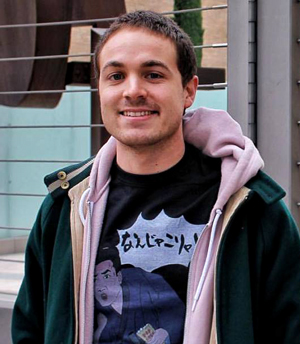
Neuroscience senior Jacob Schoen works as a researcher at OHSU’s Oregon National Primate Research Center, and his journey to that job is a lesson in persistence and faith in one’s abilities.
Schoen grew up in in a town of 2,000 in eastern Oregon. As soon as he turned 18, he set out on his own to travel and teach English in Asia. Returning to Oregon, he settled in Portland, started taking classes at Portland Community College, then found his way to Portland State, where he met instructor Bill Griesar and fell in love with neuroscience.
Last year, Schoen applied for a summer internship at the Oregon National Primate Center, but he was not one of the few interns chosen from the hundreds of submissions. Although disappointed, Schoen carried on with his own work — including outreach with Griesar’s NW Noggin, an organization that that brings art and neuroscience instruction into schools, public events, and even into the halls of the U.S. Congress. At a chapter meeting of a local neuroscience group, Schoen began talking about NW Noggin with a fellow attendee, who turned out to be a researcher from the Oregon National Primate Center. Through that connection, Schoen was offered a summer internship after all. Schoen’s research at the center focused on addiction, including analysis of the combined effects of alcohol and nicotine, and at the end of summer, he was hired to stay on, and plans to continue working at the center for a few more years, until he carries onto graduate school.
Advice:
“School has a lot of opportunities that are not necessarily presented to you in the classroom.” Schoen believes that the real challenge for a lot of students is believing in themselves. “It sounds simple and cliched to say, but there’s a mental block, because you can’t believe you can perform at that level. But when you look at Ph.D.s and people at that level, they’re people too, and they’ve gone through the same struggles. That’s the biggest hurdle. Everything else seems available in education.”

Dear EXITO Community,
This spring we have been talking about communicating our research to those in our personal and professional lives. We are thrilled to wrap up by highlighting the experience and insight of a BUILD EXITO Scholar, Sulema Rodriguez. Sulema speaks of how her personal experience with stuttering led to her research interests and to the importance of working to share what we are learning through our research in a variety of settings, making science for everyone and not just a select few.
Don’t miss our Q and A and this short video of Sulema where she tells more of her story and perspective.
Q: How would you describe your research interests?
Sulema: My research interests lies in the possible etiology of stuttering. I’m especially interested in the brain processes and potential epigenetic components involved with stuttering. Stuttering tends to vary by case and is impacted by a variety of factors (bilingualism, social context, level of stress). In order to create the best treatment, I believe that therapy must be individually personalized.
Q: What drew you to do this research?
Sulema: I began to stutter when I was around 6 years old. Throughout my life, I’ve experienced the stigma and difficulties of having a stutter. I think that the best way to break these stigma barriers is through education. I’ve always wanted to know why people stutter. I became really good at hiding my stutter. Unfortunately, this made me hide a vital part of myself. Hopefully, through research we’ll be able to improve therapy [and] the lives of stutterers.
Q: Can you talk a bit about the work you are doing with Dr. Griesar in middle schools?
Sulema: Beyond neuroscience education, we answer questions about potential careers in science. I feel that every time I attend a school, I leave a better critical thinker because of all the great questions the students ask. As students, we get to share our academic and personal endeavors. I’ve met two students in at a middle that have shared with me, that they also stutter after I shared my story. I truly think that NW Noggin is helping to inspire future scientists!
4. How does your work and research experience fit into your long term personal goals? What about your hopes for the scientific community?
Sulema: I’m currently a part of the “Stuttering Lab” in the Portland State department of Speech and Hearing Sciences. My academic goal is become a Speech-Language Pathologist and eventually obtain my P.hD. I hope that our scientific community places more emphasis outreach. Growing up, I thought science was only attainable by a select few. Through great mentors and volunteering, I’ve gained confidence and I feel like it’s possible for me. I believe that outreach has the ability to cultivate diversity; both of thought and people. Outreach helps to plant that curiosity seed; therefore, making science accessible to everyone, regardless of who you are.
Northwest Noggin Educates Franklin Students on the Brain Through Art
May, 2017
Delaney Hartmann, feature editor
5/24/2017
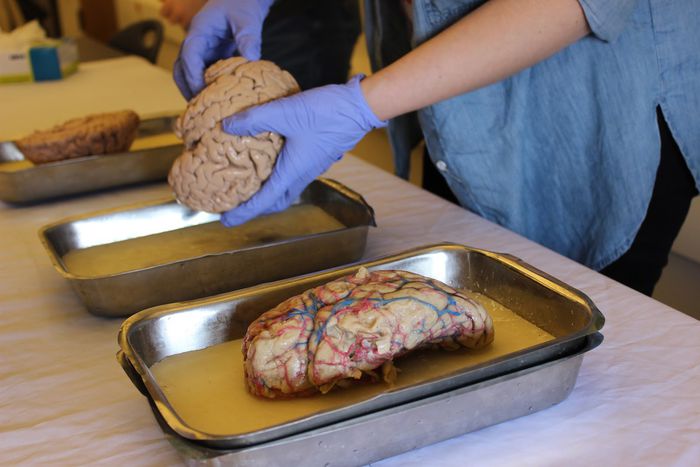
On April 25 and 26, volunteers from Northwest Noggin came to Ms. Polis’s Introduction to Psychology classes and brought along with them three human brains and one monkey brain for the students to hold and study.
OHSU “Bridges” magazine features Noggin on cover!
April, 2017
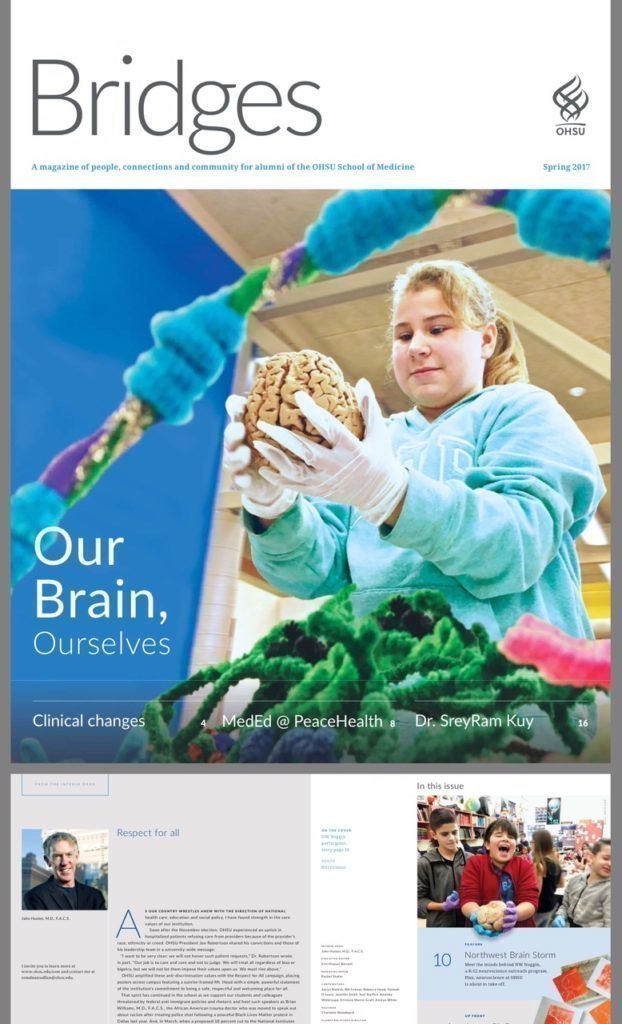
At 8 a.m. in an eastern Washington elementary school gymnasium, Bill Griesar, Ph.D. ’01, is in a situation that would make anyone else sweat. Dr. Griesar has brought his group of neuroscience outreach volunteers – undergraduate and graduate students hailing from OHSU, Portland State University and Washington State University Vancouver – to Davenport, Wash., to teach schoolchildren about brains and neuroscience. But he has just discovered that the pipe cleaners used to construct neuron models were nearly used up the day before. Unfazed, Dr. Griesar immediately concocts a new activity and somehow procures rolls of colored butcher paper from the school. Volunteers from NW Noggin rush to arrange paper on the floor to represent different lobes of the brain. Scott Jones, a fourth-year Ph.D. student in the OHSU School of Medicine’s Behavioral Neuroscience Graduate Program, tapes out an outline of a brain around the paper just as the first classes come into the gym. Dr. Griesar, simultaneously snapping photos, directing students and showing off a model brain, hasn’t stopped grinning.
READ THE ARTICLE (Spring 2017): OHSU School of Medicine Bridges Spring 2017
Thousands Hit The Streets For Portland’s March For Science
April, 2017
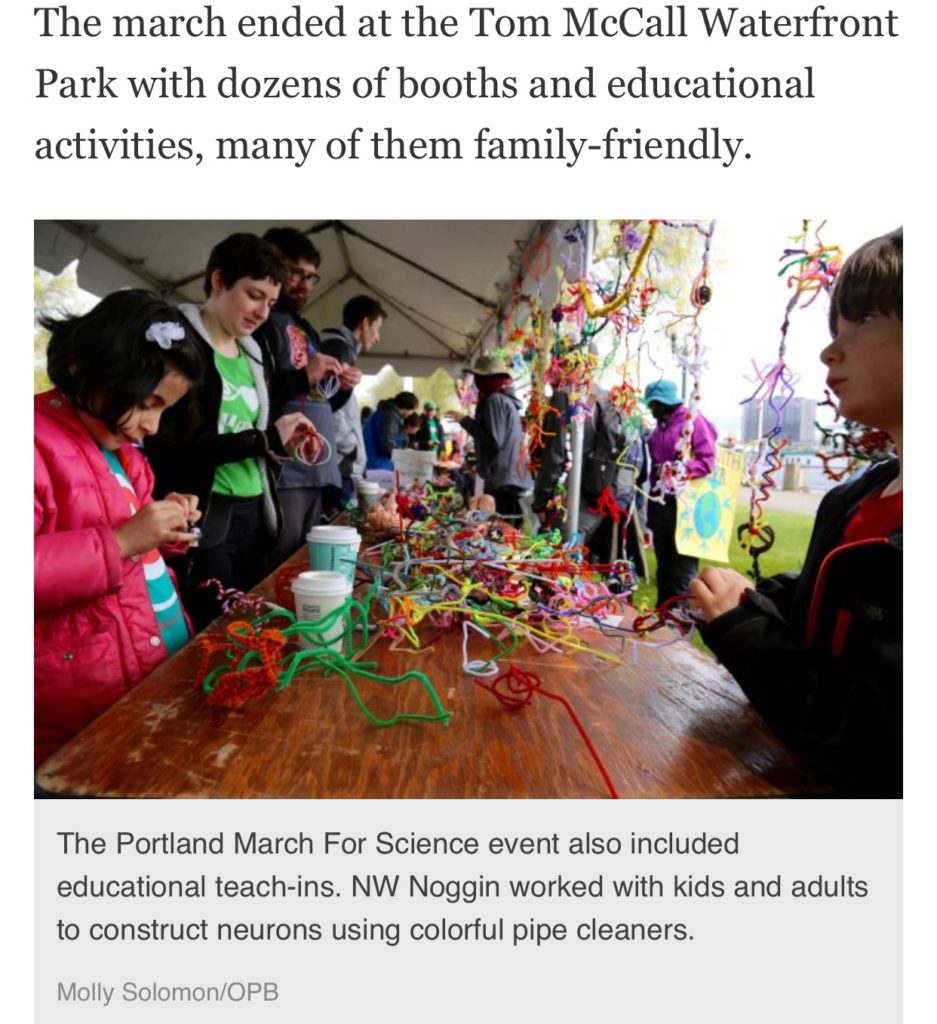
LEARN MORE: Synapsing for Science!
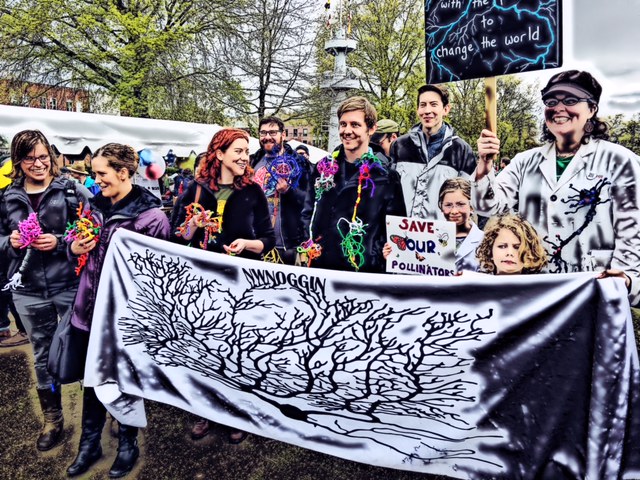
Business & education: Creating the workforce we need
February, 2017
Local firms go the extra mile to have a positive impact on youth through education


“Volunteers from NW Noggin (a regional collaborative neuroscience outreach group) worked with students to examine human brains and understand how a brain functions, including memory, anxiety and sleep patterns.”
Bound in a Net of Memories
November, 2016
“My old addiction, changed the wiring in my brain…”
– from “Chet Baker’s Unsung Swan Song,” by David Wilcox
NW Noggin outreach by artist Kindra Crick and neuroscience postdoc Dr. John Harkness was featured in an article by Kindra in the November issue of Interalia Magazine, an online publication dedicated to the interactions between the arts, sciences and consciousness…
Neuroscience-inspired art installation by Kindra Crick from Kindra Crick on Vimeo.
During the fall of 2015, I was paired with Dr. John Harkness as part of a collaboration through the Portland-based non-profit NW Noggin due to our shared interest in the molecular mechanism of memory. NW Noggin is a neuroscience outreach group that seeks to spark a lifelong interest in science and art. Founded by neuroscience educator Dr. Bill Griesar and Portland-based artist Jeff Leake, NW Noggin regularly brings together students, scientists, educators, and artists to enthuse and inform the public about neuroscience and art. At the time, Dr. Harkness had just begun a postdoc fellowship in Dr. Barbara Sorg’s lab at Washington State University, investigating the role of perineuronal nets in cocaine-relapse behavior and memory.
EXPLORE MORE: Bound in a Net of Memories
Nothing great is ever achieved without enthusiasm
June, 2016

By Christie Pizzimenti, OHSU
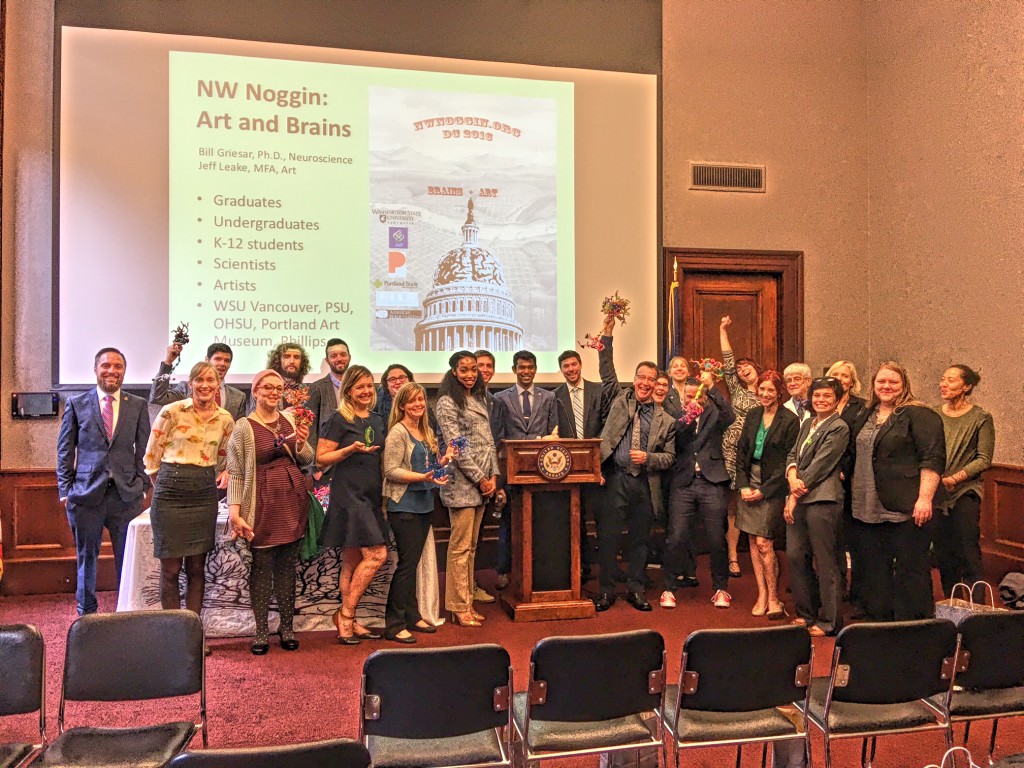
Recently, NW Noggin was invited to travel to DC to participate in “Briefing with Brains,” a week-long series of events aimed to inform members of Congress about the outstanding research and outreach efforts being made in the Pacific Northwest. While in DC we were fortunate to present our work to members of the Congressional STEAM Caucus, co-chaired by Oregon’s own Congresswoman Suzanne Bonamici, as well as members of the U.S. Senate HELP Committee…
READ MORE: Nothing great is ever achieved without enthusiasm
Christie Pizzimenti is a graduate student and Ph.D. candidate in the Department for Behavioral Neuroscience.
Neuronline Spotlight:
Educating the Public About the Brain
February, 2016
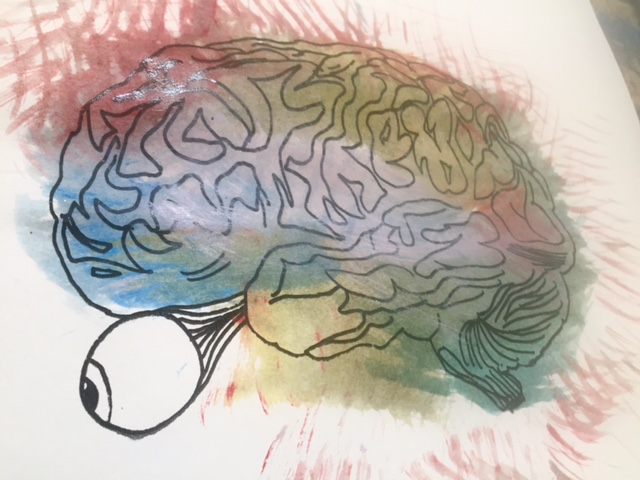
Groups like NW Noggin, a neuroscience outreach program in the Pacific Northwest, bring brain science to the public through hands-on activities like art projects. Photo courtesy of NW Noggin. Pic above by Noggin volunteer Alex Voigt.
Article: Bringing Communities Together Through Neuroscience and Art
It’s an incredibly rewarding experience to answer questions about the neuroscience of sleep and trauma at a center for homeless youth or develop an art exhibit to explain the neurophysiology of visual perception, according to representatives from a neuroscience outreach group called NW Noggin. Members explain that outreach helps students by:
- Broadening skills — Getting involved in outreach opportunities gives graduate students teaching experience.
- Gaining exposure — Undergraduates are curious about graduate opportunities in neuroscience. Working with graduate students on outreach teaches them about graduate school and about currently funded research.
- Building enthusiasm — Helping middle and high school students engage in science builds excitement about the brain and can enhance their interest in exploring research.
STEAM: An artist named Crick
May, 2016
American Society for Biochemistry and Molecular Biology Today
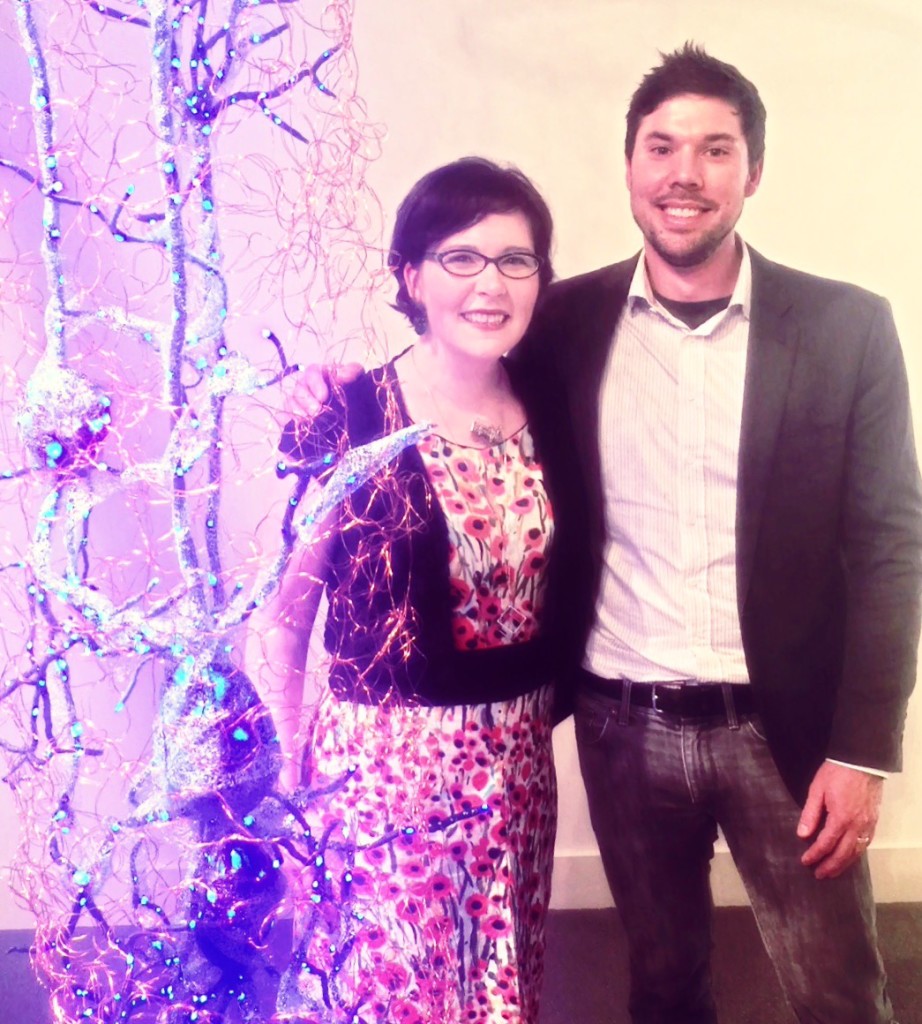
“Although she now works explicitly with scientific concepts, Crick insists she isn’t making art that’s meant to teach audiences about science. During a recent partnership with NW Noggin, a group based in Portland, Ore., and founded by an artist and a neuroscientist who pair art with science outreach, Crick collaborated on a piece intended to inspire wonder.
Working with postdoc John Harkness of Washington State University, Vancouver, Crick created a sculpture that represents an aspect of Harkness’s research on perineuronal nets, which are believed to support the preservation of memory in neurons.
Titled “Your Joys, Sorrows, Memory and Ambition” — a phrase taken from a larger quote by her grandfather — Crick’s piece is a towering spectacle. More than eight feet tall, it features neuron cables interspersed with glowing LED lights encased by wire mesh nets. The wire nets cradle the neurons, visually depicting the supportive relationship perineuronal nets provide neurons within the human brain. Crick purposely exaggerated the net structures to draw attention to their important role.
In late April, 2016, as part of a weeklong outreach trip by NW Noggin, the piece was installed at The Phillips Collection in Washington, D.C., for an event that showcased the brain and our perceptions of beauty. While there, the group also performed science outreach at local schools to bring its joint science and art curriculum from the Pacific Northwest to the East Coast.”
Brains, artwork merge for trip to D.C.
April, 2016
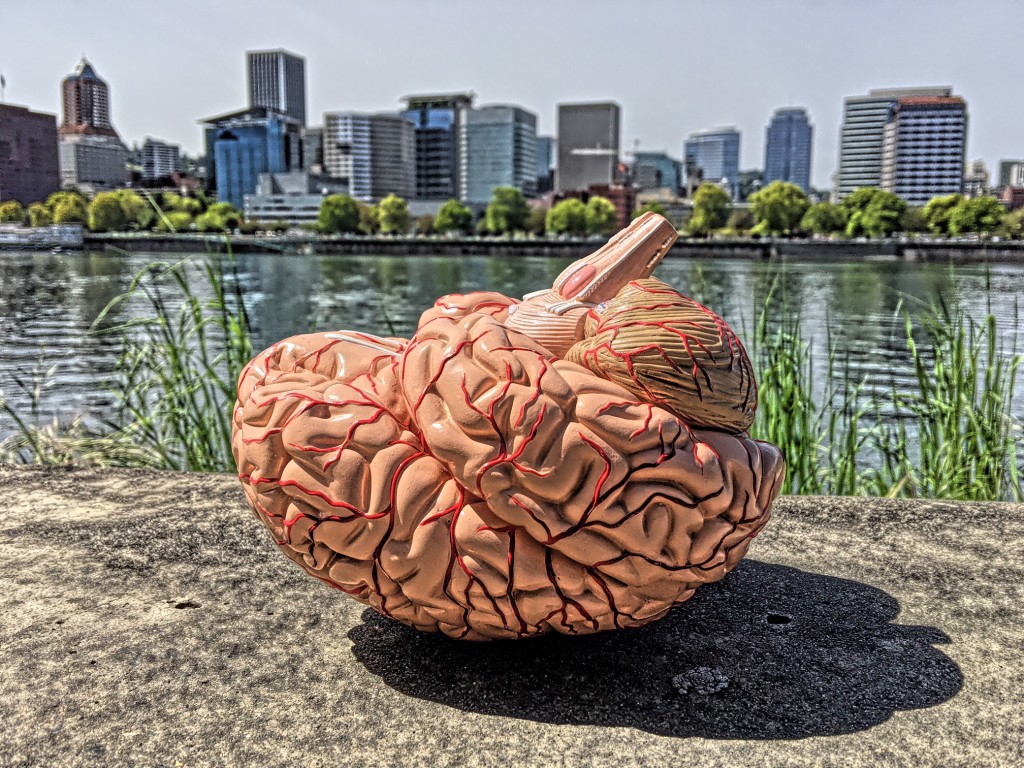
By Susan Parrish, Columbian Education Reporter
Published: April 17, 2016, 4:58 PM
A neuroscience outreach group that brings human brains and art into K-12 classrooms is taking its show to the nation’s capital later this month.
Neuroscientists, artists and students from Washington State University are part of a Neuroscience Outreach Group: Growing in Networks team that will lead several discussions about brains, brain research and brain-themed artwork April 25 to 30 at several Washington, D.C., venues — including the White House, Senate and House of Representatives.
“We take brains and art into classrooms and see people’s eyes light up. We’d be happy to bring brains to Congress,” said Bill Griesar, a Washington State University Vancouver neuroscientist, Portland State University instructor and NW NOGGIN co-founder.
In all, 28 people, including faculty and students from WSU Vancouver, Oregon Health & Science University and Portland State University will participate in the brain-related presentations and discussions.
At the House of Representatives, the group will give a “Brains + Art” briefing to the Neuroscience caucus and the Science, Technology, Engineering, Art and Mathematics — or STEAM — caucus.
“That arts-integrated approach will be a part of all of these meetings,” Griesar explained.
In a presentation to the Health, Education, Labor and Pensions committee in the U.S. Senate, NW NOGGIN members will talk about their success in developing K-12 students’ enthusiasm about brain science. The group also will explain how their community outreach events in pubs, theaters and other venues helps adults not only become enthusiastic about brain science, but also to see the value in federal funding of brain research.
At the White House, some members of the group will present at the Office of Science and Technology Policy.
“We’ll get an opportunity to talk about the need for federal dollars to fund neuroscience,” Griesar said. “We’ll also talk about how our students have been involved in these arts-integrated outreach activities. They are very interested in learning how these arts-integrated research programs work.”
When the NW NOGGIN group visits two low-income elementary schools in Washington, D.C., students will have the opportunity to observe human brains close up. After learning about how the brain’s neurons work, students will build their own replica neurons from pipe cleaners. Then they will examine brain-inspired artwork and will make Petri dish art prints.
Later in the week, the students’ artwork will be displayed at the Phillips Collection, a museum of modern art for a special NW NOGGIN presentation called “Brains, Beauty and Brews Neuroscience Night.” The event will highlight the brain science underlying human perception of landscapes. Two weeks before the event, Neuroscience Night at the Phillips was already sold out.
Neuroscience Night will include the exhibit “Seeing Nature: Landscape Masterworks” from the Paul G. Allen Family Collection. It features 39 masterpieces spanning five centuries and explores the evolution of European and American landscape art.
Neuroscience Night asks the question: How does your brain react when you look at artwork? In a “brain makerspace,” participants can hold and examine human brains, try brain challenges in conjunction with the art exhibit and create a neural-network art piece.
“We’ll be talking about the neurophysiology of visual perception: How you see with your brain. What parts of the brain are involved in perceiving colors and depth and contrast and spatial relations. Your emotional response to the work. The memories it calls up,” Griesar said.
The “brews” part of the event will include Northwest beer and wine provided by Burnt Bridge Cellars in Vancouver and beer by Fort George Brewery in Astoria, Ore.
“Since we’re going to be highlighting Northwest neuroscience and art, we thought we’d also approach Northwest beer and winemakers,” Griesar said.
The human brains for all events will be provided by the American Brain Coalition, a nonprofit organization comprised of leading professional neurological, psychological and psychiatric associations and patient groups. They will bring several human brains with various characteristics, including a brain with Alzheimer’s.
The WSU Vancouver contingent will include Griesar; Jeff Leake, artist, instructor and neuroscience outreach coordinator; Barbara A. Sorg, Integrative Physiology and Neuroscience; Christine Portfors, Biological Sciences; Chancellor Mel Netzhammer; eight undergraduate students, three graduate students, one post doctoral student and one recent graduate.
The three universities provided money for the trip.
“The grad students are getting terrific opportunities to explain their work to the general public. To make some pretty extraordinary work more accessible. To let people know what they’re doing,” Griesar said.
So far through its outreach efforts, NW NOGGIN has reached about 9,000 K-12 students and about 1,000 community members. But with the exposure to lawmakers and other influential leaders in Washington, D.C., that number of brain enthusiasts will continue to grow.
“The brain is amazing. It grabs people’s attention,” Griesar said. “You want to know how your brain works. You want a user’s manual.”
Susan Parrish: 360-735-4515; twitter.com/col_schools; susan.parrish@columbian.com; www.facebook.com/schoolsclarkcounty
NW Noggin Invited to present in Washington, D.C.
March, 2016

Five Portland State students will travel with the neuroscience outreach group NW Noggin, led by Psychology Instructor Bill Griesar, to Washington, D.C. to give a “Brains + Art” briefing to the Neuroscience and the Science, Technology, Engineering, Art & Mathematics (STEAM) caucuses in the US House of Representatives on April 27. They will also present to the Health, Education, Labor and Pensions (HELP) committee in the U.S. Senate.
NW Noggin brings together undergraduate and graduate student volunteers from across PSU and other area institutions to inform and excite K-12 students, and the community, about neuroscience.Read more about NW Noggin’s upcoming Washington, D.C. visit.
Our Brains: Where Science and Art Meet
March, 2016
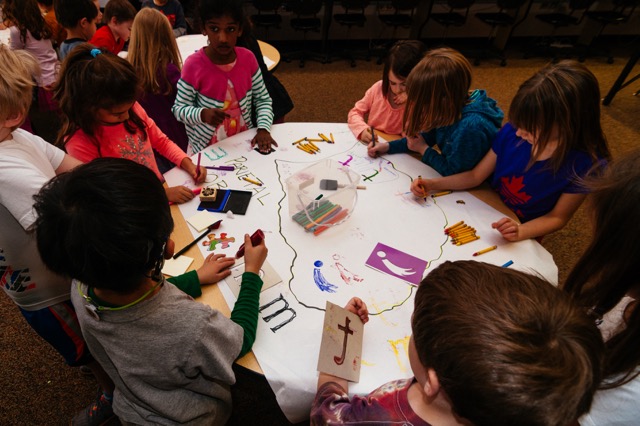
Bonny Slope welcomed five entertaining and creative neuroscience researchers and artists from NW Noggin (Northwest Neuroscience Outreach Group: Growing in Networks) to the Bonny Slope library last month for three days of exploring the brain-art connection. During the three hour-long presentations, one for grades K-1, 2-3, and 4-5, respectively, kids saw a skit about brain function, built neurons from pipe cleaners, mapped brainy pathways in crayon, and even held real human brains!
NW Noggin is a largely volunteer effort to bring scientists, artists, and students of all ages together to share their expertise and encourage young people to get excited about science and art.
Bonny Slope is currently featured on the NW Noggin website, where you can see some of the fun and interesting aspects of the presentations.
This opportunity was funded through BSCO’s Artist in Residence program.
Noggin Takes DC
March, 2016
Learn more about Noggin outreach in Washington DC. In April we’ll be at the Phillips Collection – where the “Seeing Nature” exhibit is open to the public through May…


BRAINS, BEAUTY, & BREWS
NEUROSCIENCE NIGHT
APRIL 28, 2016, 5:30–8 PM
Have you ever wondered how your brain reacts when you look at an artwork? Join us for a brainy night with NW Noggin—the Pacific Northwest neuroscience education partnership—and discover the brain science underlying our perceptions of beauty. In a special “brain makerspace,” participants can hold and examine real human brains from the American Brain Coalition, try out brain challenges in Seeing Nature: Landscape Masterworks, play with a new brain app that allows you to interact with a brain superimposed on their own heads, and sample Pacific Northwest beer and wine from Fort George Brewery and Burnt Bridge Cellars. Let off some “STEAM” (Science, Technology, Engineering, Art, and Math) by creating your own neural-network art piece. Explore artwork by Kindra Crick, granddaughter of Nobel Prize winning scientist Francis Crick and artist Odile Crick, which demonstrates how neural connections are essential for perceiving artistic landscapes.
Galleries Magazine

Brains, Beauty, & Brews: Neuroscience Night at the Phillips
Explaining Art to a Scientist
March, 2016
When a non-scientist walks into a scientific talk, they often wonder if the science will make any sense to them. Will I learn something? Will it be interesting? As a scientist firmly entrenched in my left cerebral hemisphere (yes, I know it’s not that simple!), I often have the same reaction to visual art. Will I understand, or at least appreciate the art? Will it make sense? I know, art isn’t always supposed to make sense, at least not in a logical, science-minded way. Still, as a scientist, visual art often leaves me scratching my head.
That’s why I’m so excited about last Wednesday’s Velo Cult talk on neuroscience and memory, sponsored by NW Noggin. These regular talks pair a neuroscientist with an artist, merging the two seemingly disparate disciplines to better reach wide audiences. Wednesday night found neuroscientist Dr. John Harkness of Washington State University Vancouver matched with Ms. Kindra Crick, an internationally recognized artist…and the granddaughter of Nobel prize winner Francis Crick, who helped to discover the underlying structure of DNA. Ms. Crick is a scientist in her own right, with a background in molecular biology and a broad understanding of neuroscience. Kindra exemplifies the type of expert communication I preach in this blog – she explained her art to a mostly scientific crowd, and I got it! Granted, she also worked in a heavy dose of science, and her sculpture depicting perineuronal nets surrounding neural networks was both visually stunning and scientifically (mostly) accurate.
As scientists, we can learn from Kindra’s example. She straddled both worlds – art and science – and brought both to life. How can we, as scientists, bring art into our work, or at least into our public talks, in a way to bridge the divide? Post with your favorite examples!
Bringing Communities Together Through Neuroscience and Art
February, 2016

The Society for Neuroscience (SfN) is the world’s largest organization of scientists and physicians devoted to understanding the brain and nervous system. The nonprofit organization, founded in 1969, now has nearly 40,000 members in more than 90 countries and 130 chapters worldwide.
Neuronline is the SfN members-only home for learning and discussion. Neuronline content, created and curated by leaders in neuroscience and SfN partners, is regularly updated to reflect the most relevant issues in the evolving neuroscience field…
Jeff Leake and Bill Griesar recently collaborated on a Neuronline piece about NW Noggin’s extensive, ongoing STEAM outreach efforts in the Pacific Northwest.
For non-members, we have reprinted the article at this link…
HELA Students Examine Brains from NW Noggin Group
January, 2016

Skyview, Fort Vancouver students observe brain surgery
January, 2016
More details available here at nwnoggin.org: Brain Watch Wednesday

Skyview, Fort Vancouver students observe brain surgery | The Columbian
A few media links regarding the “Seeing Nature” exhibit at the Portland Art Museum
(Details on our collaboration are found in this post, “The Nature of Seeing: Noggins and Art“)
October, 2015
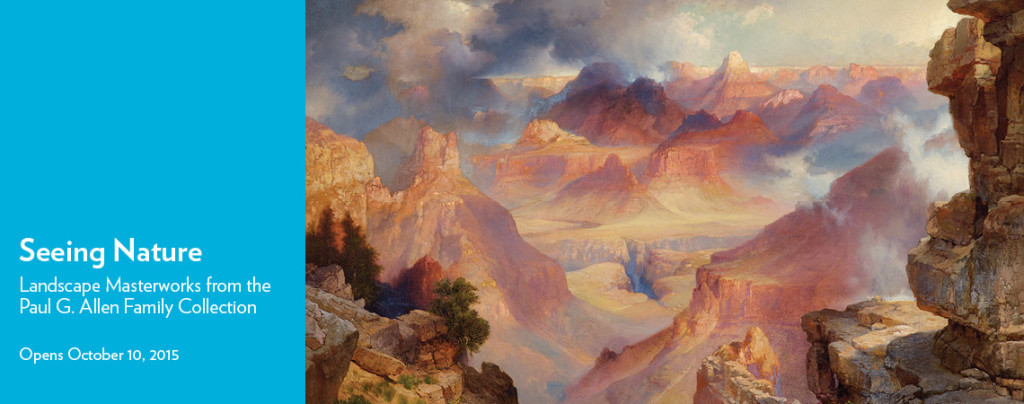
LETTING NATURE TAKE ITS COURSE (Portland Tribune)
Paul Allen to Share His Art With America in a 5-City Traveling Masterpieces Show (Observer)
EXHIBITION OF WORKS FROM PAUL ALLEN’S PRIVATE COLLECTION BEGINS U.S. MUSEUM TOUR (Vulcan)
Selections from Paul Allen’s Massive Art Collection on View in Touring Exhibition (ARTFIXdaily)
Paul G. Allen’s Landscape Collection Begins National Museum Tour (Hamptons Art Hub)
Seeing Nature: Landscape Masterworks from the Paul G. Allen Family Collection (Art History News)
Portland State University News: “The Nature of Seeing”
From the Portland State University Vanguard
September, 2015

Let’s turn STEM into STEAM
SCIENCE AND THE ARTS ARE A MATCH MADE FOR BETTER LEARNING
This is your brain on Vortex IPA
September, 2015
From the Coast Weekend, September 28, 2015
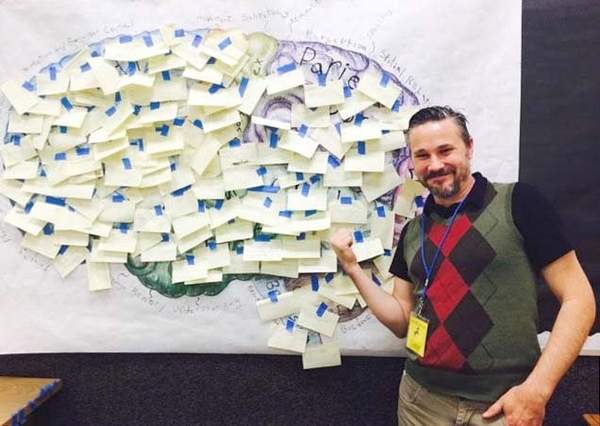
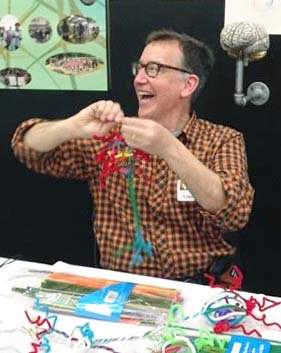
From the OHSU Behavioral Neuroscience newsletter
September, 2015
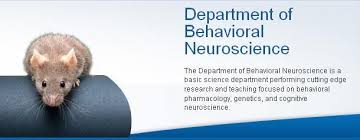
Bill Griesar Does the Media Rounds
April – June, 2015
From OHSU Behavioral Neuroscience (6/23/15)
Man of many hats (2001 Ph.D. graduate; adjunct professor, OHSU, PSU, WSU Vancouver; neuroscience director, NW Noggin), Bill Griesar, was recently featured in the Oregonian and the New Statesman, the U.K. version of The Atlantic Magazine. Follow the links below to read the articles:
Joseph Rose: Why it’s perfectly normal to turn down the car radio when you’re lost (Oregonian June 11, 2015)
Familiarity breeds contempt: why do we get bored, and what is the point of boredom? (New Statesman, June 9, 2015)
From Vancouver Public Schools (5/13/15)
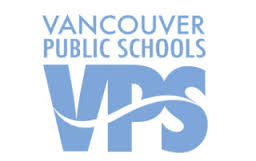
From Vancouver Public Schools (5/8/15)

Understanding the Brain at Skyview High School
From Vancouver Public Schools (4/21/15)

Brains, brains everywhere—and lots of thoughts to think
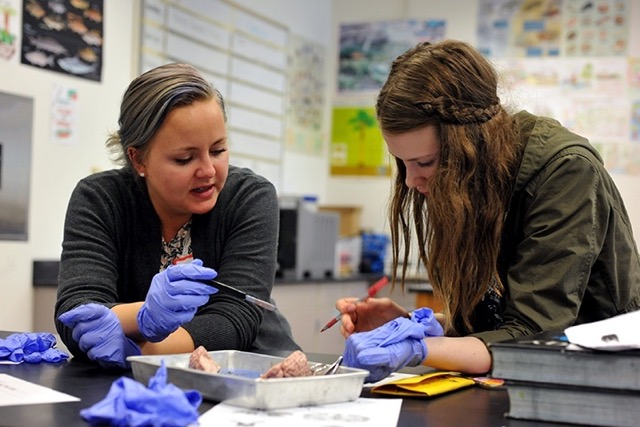
From GEAR UP Washington State (4/21/15)
NW Noggin Teams up with Skyview HS

A current of excitement hummed in the Skyview High School biology lab on April 16. Visitors from NW Noggin unloaded real sheep’s brains, about the size of an apple and the color of clay, into metal dissection trays as some 20 high school freshmen, sophomores and juniors looked on…
From The Columbian newspaper (4/16/15)

Skyview students go inside the noggin
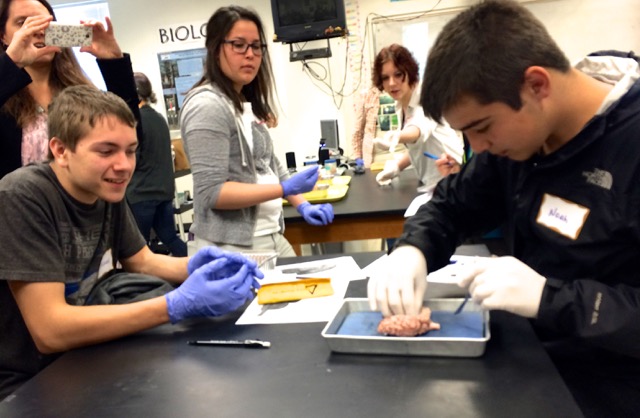
The college volunteers work under the umbrella of NW NOGGIN, led by neuroscientists and WSU Vancouver instructors Bill Griesar and Jeff Leake. Since September, NW NOGGIN has taken lessons on the road to the Oregon Museum of Science and Industry, a series of brain lectures to the Newmark Theater in downtown Portland and to about 3,000 students in Clark County and Portland schools. Thursday was the fourth time the volunteers had visited Fojtik’s classroom.
From NW Crimson & Gray, Spring 2015
Spring, 2015

NW Crimson and Gray Spring 2015
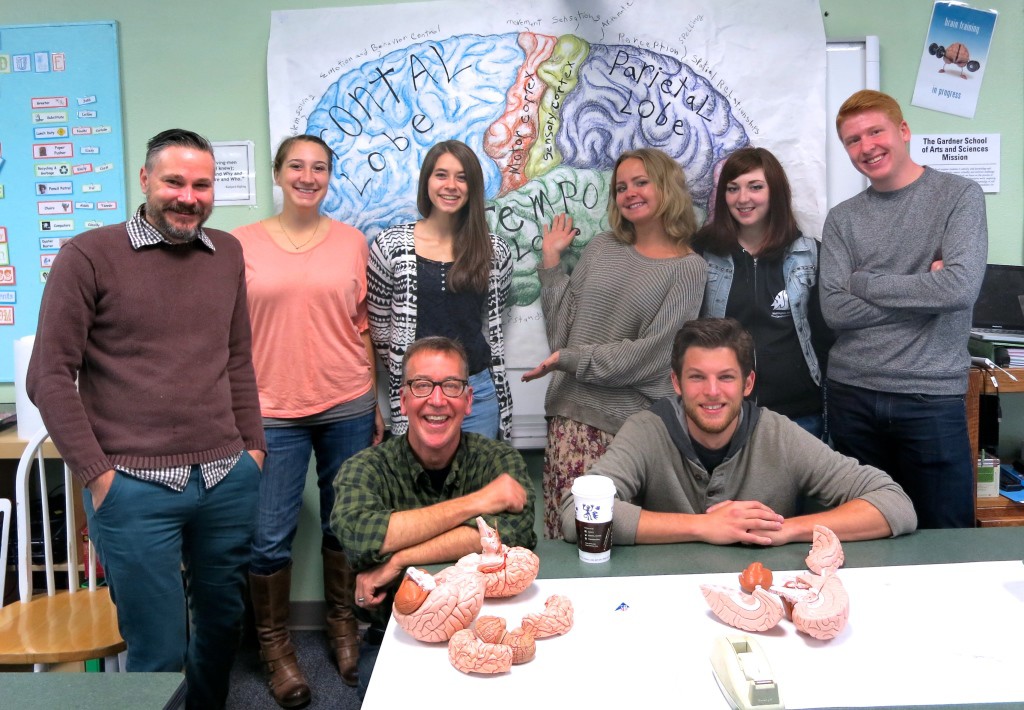
From the VanCougar
January, 2015

Science and Art Combine to Make the Human Brain
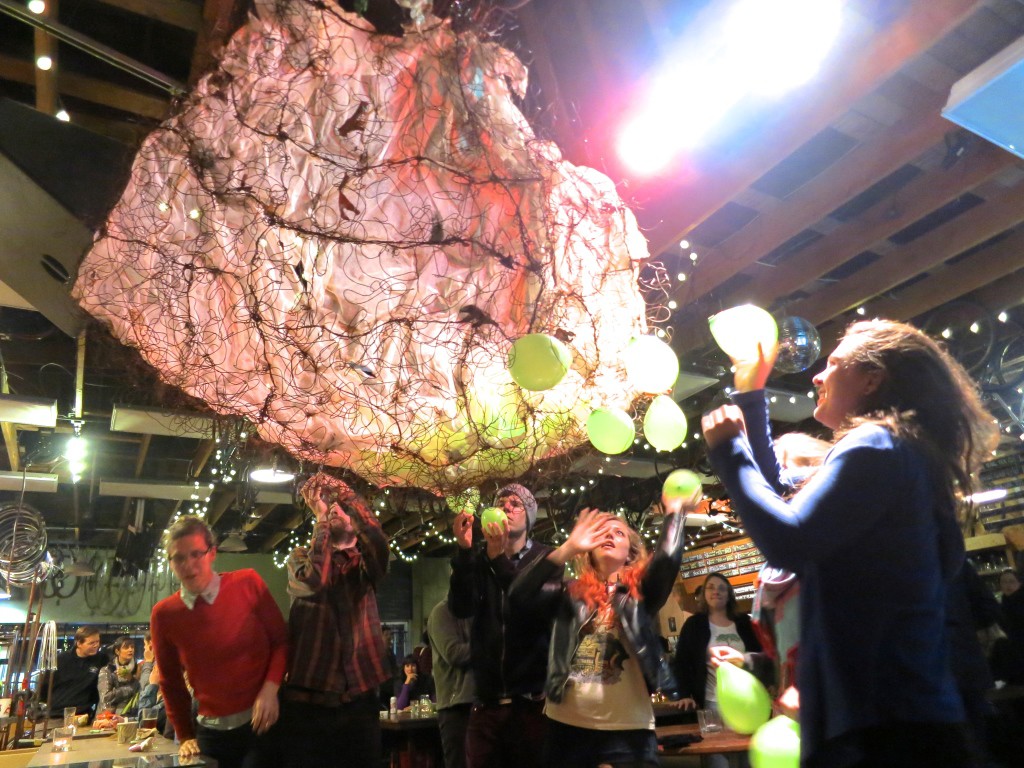
From Patton Middle School in McMinnville, OR
October, 2014
Patton Middle School Lesson Combines Literature and Science
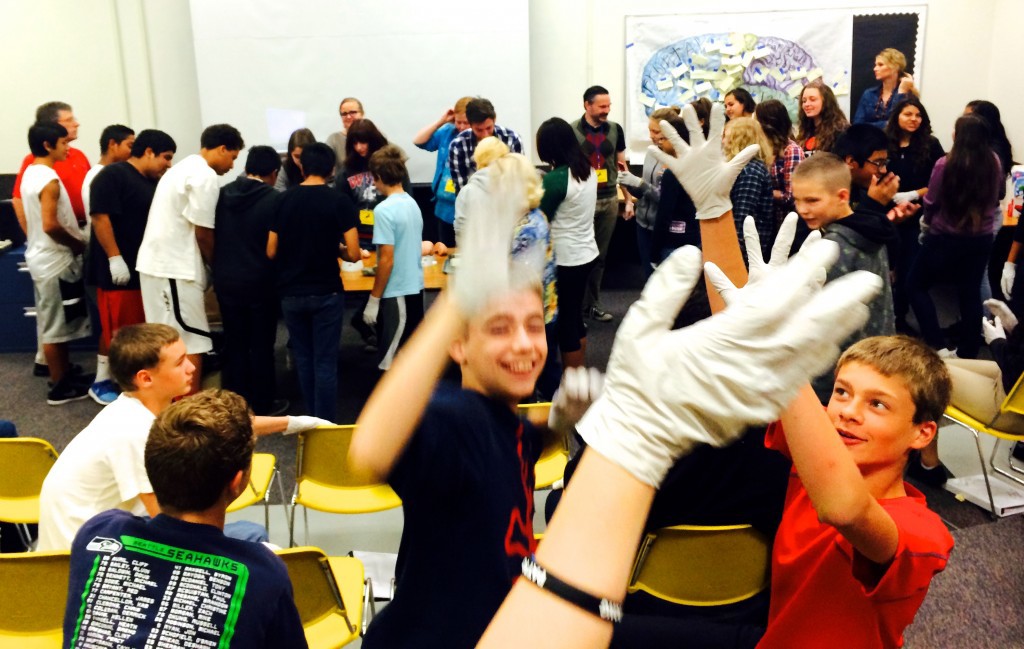
From OHSU Behavioral Neuroscience newsletter (2014)
Summer, 2014

From the Association for Psychological Science Observer print and web editions (April, 2014)…
Neuroscience Outreach
March, 2014
Graduates, Undergraduates, High School, and Middle School Students Get Together to Learn About the Brain

KGW – Channel 8 News did a story about our Madison High School outreach efforts in 2013:
Brain Dissection at Madison HS
A Network of Neurons, College of Liberal Arts and Sciences
From Portland State University

From Portland Public Schools
August, 2013

Neuroscience takes Madison HS incoming freshmen by (brain) storm!
Parent-created program brings hands-on neuroscience to students August 01, 2013 Madison High School students dissect a sheep’s brain during a summer program. Photo by Katharine Kimball
Madison High School students dissect a sheep’s brain during a summer program. Photo by Katharine Kimball
A three-week summer program to better prepare Madison High School freshmen weaves in neuroscience, art, college students, mentoring and … a sheep’s brain.
No bigger than a closed fist, the brain lies in the center of a shiny metal tray, a spongy slab the color of a cooked pork tenderloin. The cluster of rising Madison High School freshman peering down at the tray don’t quite know what to make of the brain.
Oregon Health & Science University graduate student John Harkness, a doctoral candidate in behavioral neuroscience, tells the teens it’s time to begin the dissection.
And so it goes inside an innovative effort that brings hands-on science learning to at-risk students and exposes college students to teaching. The summer neuroscience program, developed by a Portland Public Schools parent, has expanded this year. It now takes place at three PPS schools, including Madison High, where the program joins another project that helps academically challenged students prepare for the important transition from middle school to high school.
Created by Portland State University Adjunct Professor Bill Griesar, father of students at Sabin School and Benson High, the neuroscience program also is taking place this summer at Sabin and Jason Lee schools.
Gear Up, a federal grant that promotes college awareness and preparation for low-income students at several PPS schools, is funding the Madison partnership through a grant.Madison 9th-grade teacher Erin Tillery likes that the neuroscience program teaches students about perception, optical illusions and other ways all brains work — but also educates students about how their brains function individually.
“They’re learning about themselves as learners,” she said. “And they’ll be able to capitalize on that as freshmen.”
After just a few days in the program, Trevaughn Williams, 14, said he’s learned fascinating things about the brain and he’s made new friends and become confident about starting high school.
Williams is one of 80 participating Madison students. They spend mornings studying neuroscience and art. Griesar, who has taught at four colleges, pulled together a team of partners, including PSU, Washington State University and Pacific Northwest College of Art. College students lead experiments but also gain exposure to teaching.
Afternoons at Madison are devoted to preparing for high school, learning expectations, building community, and becoming familiar with Madison. The partnership includes SUN Community Schools, and eight Madison rising seniors and recent graduates work as mentors.
The collaboration’s curriculum — from fun stuff such as making art project brains to playing games wearing headsets that measure brain activity — also features writing assignments and reading strategies. The goal is to help students process what they learn, as well as prepare them for the reading and writing challenges they’ll face in high school, said Santha Cassell, instructional specialist at Madison.
“What I hear from kids all the time is that they want hands-on learning,” Cassell said. “This is all hands-on learning and hands-on neuroscience.”
At Portland Public Schools, this is our goal: By the end of elementary, middle, and high school, every student by name will meet or exceed academic standards and will be fully prepared to make productive life decisions. For more information on Portland Public Schools, call 503-916-3304, e-mail us at pubinfo@pps.net, or visitwww.pps.k12.or.us. Portland Public Schools is an equal opportunity educator and employer.




